
432 AND ABOVE EME NEWS
September 2025
Volume 54 Number 9
Editor: Peter Blair G3LTF
Production Assistance: Dave G4RGK & Frank NC1I & Bob W1QA
News, Contests and Dx-peditions
The second microwave leg of the ARRL EME contest was completed over the weekend of September 13/14th with again high levels of activity on 3 cm, a moderate amount on 13 cm and 6 cm but very low on 9 cm. Due to holidays I am writing this before most reports are in but on 3 cm F2CT added 24 to take his total to 62 and OK1DFC added 14 to make his total 53. On 13 cm OK1DFC’s total of 39 looks good. We struggle each year to fit activity on 5 bands into 2 days, (and not find ourselves changing the feeds in the night-time.) It’s a pity that 9 cm gets squeezed out, it’s such a good band for EME.
Alex, EA8DBM, activated 5 countries on 23 cm in the last month with his folding dish system, in 3 of them he was able to give some 13 cm contacts, see my summary below. His “travelogue” is well worth reading, he went to amazing lengths to overcome obstacles to do this, driving thousands of km, and the microwave community is enormously grateful. Well done Alex! (and a special thanks for the CW! -Ed)
Regarding the AST SpaceMobile incursion into the 70 cm band, the following was posted by AMSAT UK:
“The FCC has approved the global use of 430.5, 432.3, 434.1, 435.9, 439.5 MHz with 50 kHz bandwidth transmissions by 20 commercial satellites in the AST SpaceMobile constellation subject to restrictions
https://www.fcc.gov/document/ast-science-att-verizon-and-firstnet-applications-public-notice
The approval only applies to the first 20 satellites, presumably those already constructed, of the 248 satellite constellation and limits the activation time to no more than 24 hours continuously and only when no other frequencies can be used during the Launch and Early Orbit Phase (LEOP). While not an outright rejection of AST's proposal the wording used by the FCC suggests future applications from other companies to use the 430 MHz amateur band are unlikely to be successful.”
Contests
The final legs of the ARRL EME contest (50-1296 MHz) are on October 11-12th and November 8-9th. http://www.arrl.org/eme-contest
Dx-peditions
Alex EA8DBM plans to be in Korea operating as HL2/LY3UM, October 8-12th.
DJ3JJ Andreas
I was QRV in the ARI Contest Saturday and Sunday. I only worked G3LTF on CW. No other stations were heard. The Sun noise on my 2.5 m dish was S4 because of the close proximity of the Sun to the Moon. The weather was extraordinarily good, so I decided to skip the Saturday afternoon part of the ARI Autumn contest and go for a tour through the black forest. We had 30 C for the trip and clear blue sky.
Later on Saturday when I switched on, the S-Meter was showing S7 of noise but nothing on CW or digital. Sun was only 4° AZ and 1° EL away from the moon and my dish has abt 6° 3 dB beamwidth. G0LBK inspired me to move the dish a bit out of the sun noise. So I added +1.5° Azimuth and suddenly my PC was able to decode signals. The S-Meter was still showing close to S7 and nothing was heard on CW. My RX performance was abt 8 dB down to normal
I made QSOs with the following stations in digital: G0LBK 4 m (TX -22 / RX -19), I0NAA 5 m (-20 / -12), RX3DR 3.7 m (-24/-23), UA9FAD 3 m (-24/-17), IK7EZN 3.2 m (-20/-20), PA0TBR 3.5 m (-18/-21), IK2DDR 3.7 m (-18/-15), IK5VLS 4 m (-21/-17), YO2LAM 4.5 m (-19/-16), ES3RF 3 m (-21/-24), F1RJ 3.8 m (-21/-19). Called with no reaction IQ2DB (3 m dish).
DK3WG Jurg
In September worked the following new ones on 23 cm using Q65-C: ZA/LY3UM (DXCC,JN91+KM09), TA1/EA8DBM (DXCC), JA4UMN, R1NW, GW4ZHI, KD2LGX, K9ZBU
EA8DBM DXpeditions
(Alex is unable to send a report on his several DXpeditions this month due to travelling (3000km) and the need for urgent repairs before his next trip which is to Korea HL, October 8-12th. I am therefore putting together a short summary based on the material in https://ea8dbm.substack.com/ - Ed)
OH0/EA8DBM 14-18th August: Before leaving home re-focussing the dish got the sun noise up to 7.5-8.5 dB and echoes –24.5 dB. In OH0 on 23 cm a total of 67 QSOs and 10 QSOs on 13 cm, including one with PA7JB wih his 2.4 m / 200 W system.
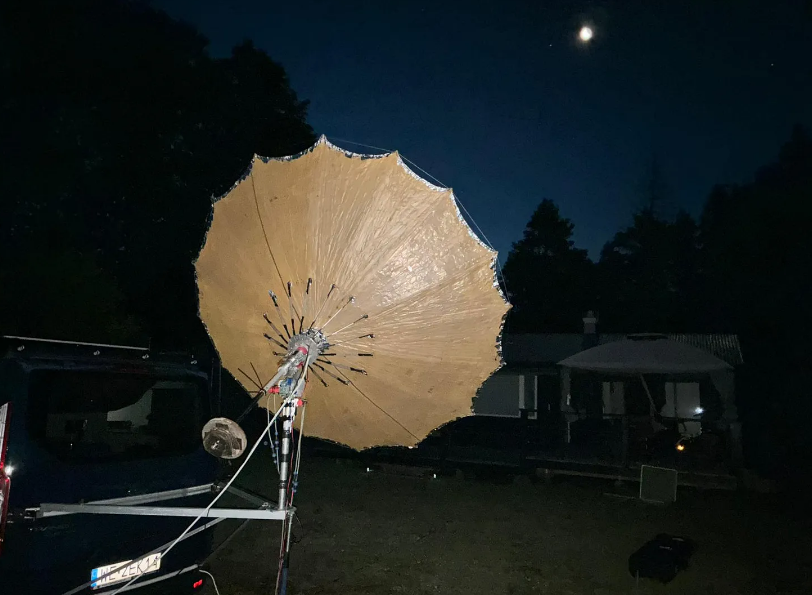 EA8DBM OH0 dish
EA8DBM OH0 dish
YL/EA8DBM 20-21st August: 56 QSOs on 23 cm and 7 QSOs on 13 cm. 2320MHz was unusable due to LTE QRM and so the 13 cm QSOs were on 2304 and 2300 MHz.
LY3UM 24-26th August: 57 QSOs on 23 cm including 2 CW and 7 QSOs on 13 cm, again on 2304 and 2300 MHz due to severe QRM on 2320 MHz.
ZA/LY3UM 5-6 September: 59 QSOs on 23 cm
TA1/EA8DBM 9-10 September: 77 QSOs on 23 cm
ZA/LY3UM 13-14 September: 27 QSOs on 23 cm, total 86 QSOs from Albania. The 13 cm PA failed so no QSOs on that band.
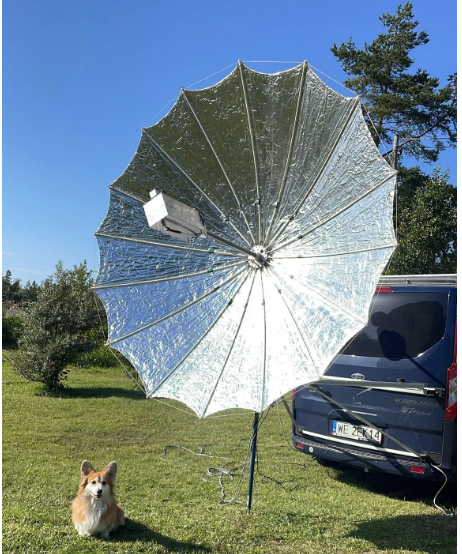 EA8DBM folding dish new assistant
EA8DBM folding dish new assistant
F2CT Guy
Here is my report about last party during ARRL EME test on 10 GHz.
Activity was high on Saturday morning and lower on Sunday, I think there are around 70 stations QRV on 10 GHz specially in Q65D. Around 10 stations were missing last weekend. I worked several stations with only 10 W and 90 cm.
Here are my September results:
- BD4SY ; F6BKB ; GW3TKH ; HB9Q ; IK3GHY ; I6YPK ; KL6M (1ère Alaska!) ; N2END ; NJ6D ; OH1LRY ; OH2DG ; ON5TA (CW) ; OZ1FF (CW)
- OZ7Z ; PA0PLY ; PE1CKK ; PA3CSG ; PA7JB ; SA6BUN ; SO5AZ ; UN6PD ; VE4MA ; VK4WYM ; W3TI
- 24 stations more added to 38 QSOs on August 16/17 for a total of 62.
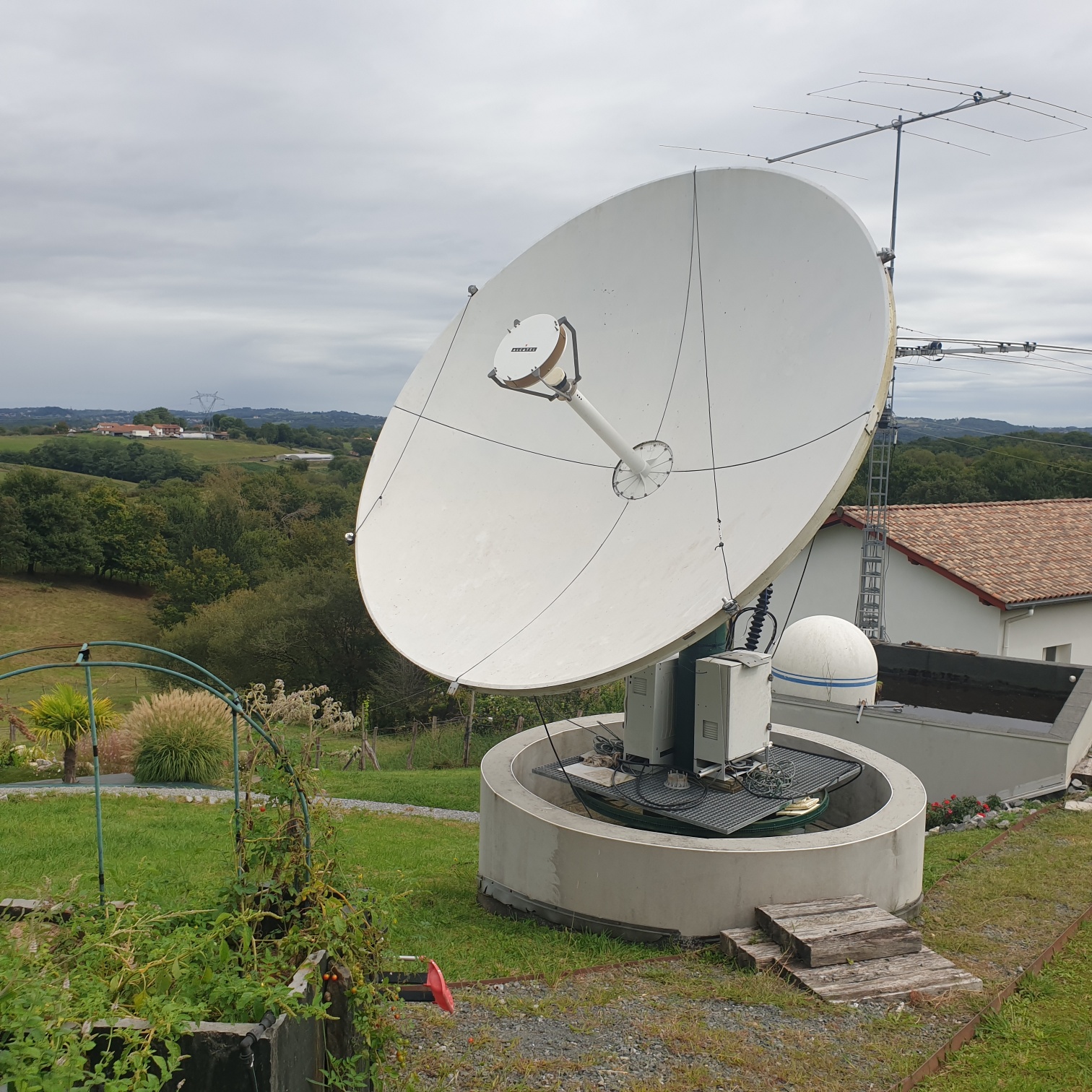 F2CT 3.7 m Cassegrain dish
F2CT 3.7 m Cassegrain dish
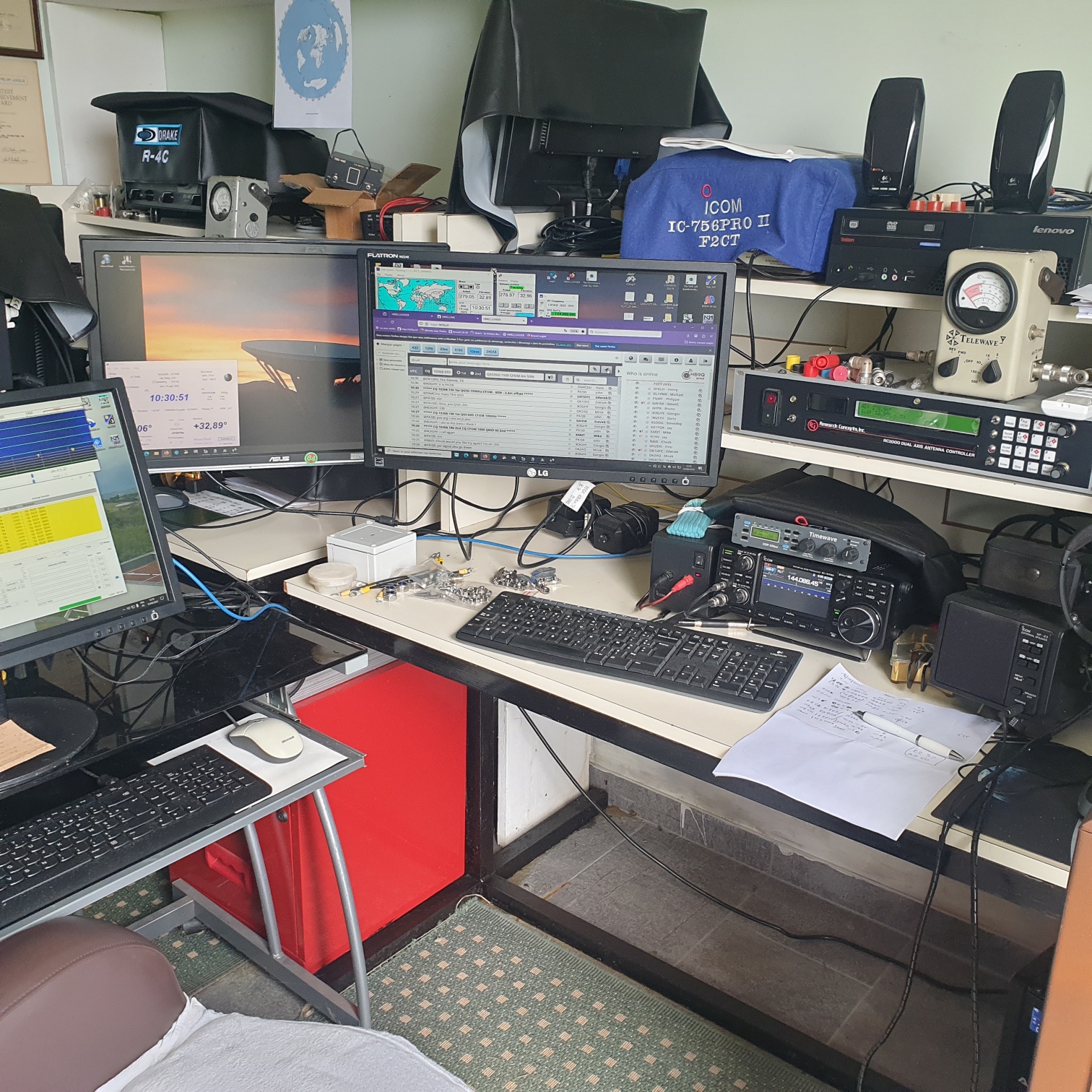 F2CT Operating Position
F2CT Operating Position
G3LTF Peter
On August 24th I put the 23 cm feed in and worked on CW, DF3RU and ZS6CCY #562. A special contact for me as Bill had helped Peter Carey ZE5JJ build his 32 ft dish that I worked him on in 1981 (see pic). Next, LY3UM #563 and DXCC #87, a nice 549 signal, the first time I had been able to work Alex on his dxpeditions and my first new DXCC since November ‘23. I also worked G4YTL.
On August 25th I tried with NY1V who was 549 but he couldn't copy me. I did work DK3EE, DK0VHF, DM0A, all from the same station, and then AC2AC #564. In the second leg of the ARRL contest on September 13th on 13 cm CW I worked SP3XBO, VE6TA, IW2FZR, IK3COJ, WAS6PY, K5DOG #163, DF3RU, HB9Q, KN0WS #164 and G4CCH on SSB. 13 cm total 20.
Next day I changed to 6 cm and worked, UA3PTW, OH1LRY, OH2DG, OH3LWP, SM4DHN, WA6PY and SP6JLW. 6 cm total 12. Both bands an improvement on last year. I did not use 9 cm as although it is working again I hadn’t tried it in the dish since its repair.
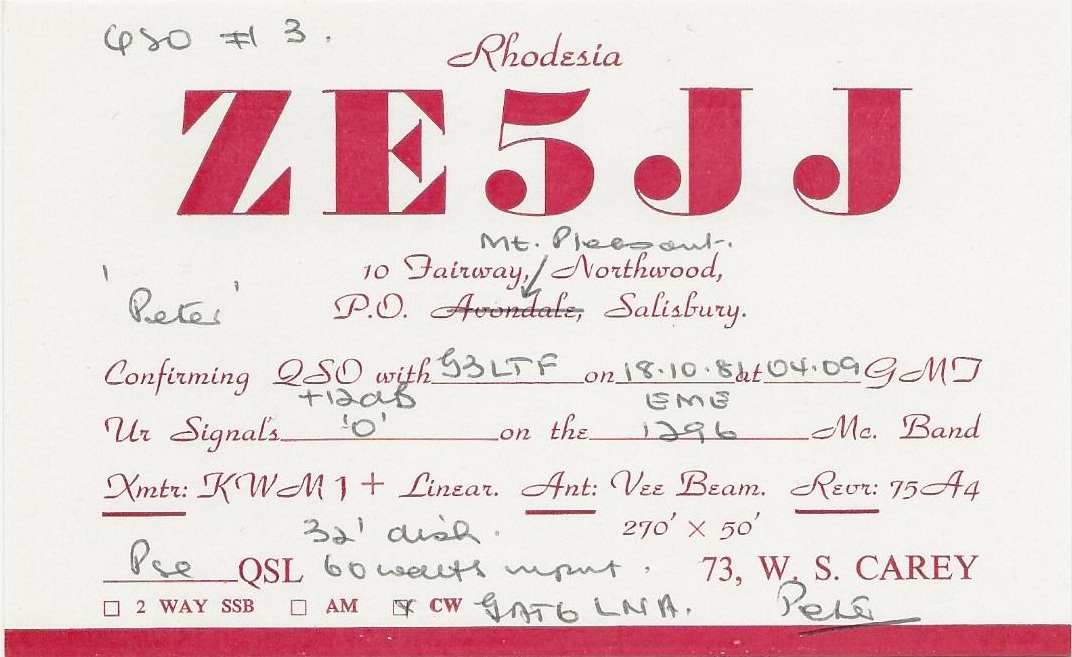 G3LTF ZE5JJ 32ft dish 1981 note 60W input power
G3LTF ZE5JJ 32ft dish 1981 note 60W input power
G3YEG Nic
Just 4 new decodes on 70 cm over the last couple of months:
Using 15 ele SM4GGC -32 dB (Much better on 9 ele at -22 dB later on in month at higher elevation), WC8RK best of -25 dB, then using 9 ele at high elevation OE3JPC -19 dB, OM3TRN best of -23 dB all decodes horizontal.
Just one decode from Frank NC1I at -30 dB when set ant vertical for a change - but I discovered that the ant had fallen down in the attic (poor knot tying) and was 55 deg off the moon.
Having set the ant back up again more securely, as Eu-Eu has been poor, tried 15 ele set vertical for a few days without any new decodes. 2 more easy QSOs with Frank NC1I using 9 ele. One failed QSO attempt with Frank on the 15 ele set vertical which was odd as my best ever report from Bernd DL7APV (sk) at -21 dB was using very similar position for the 15 ele vertical in the attic.
While having dinner one evening, I left the rig on Peter's PA2V QRG (in case he worked a new station) and following intense sunshine all day a heavy rain shower came along and quickly soaked the roof. This is what I saw using just the 9 ele - its response is very flat even over this time period.
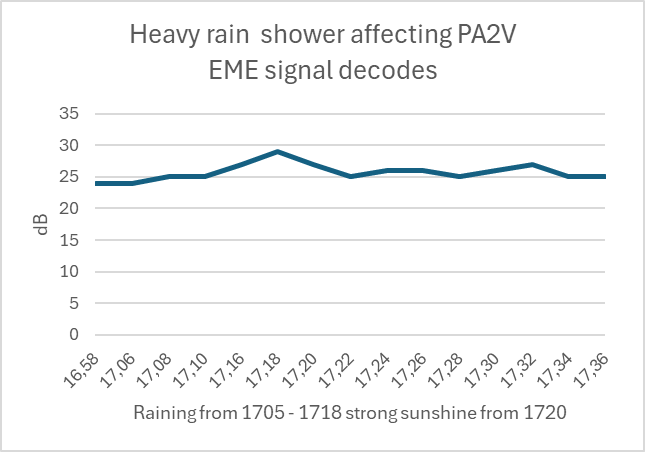 G3YEG rain affecting PA2V decodes
G3YEG rain affecting PA2V decodes
The response is remarkably quick in both the degradation (not too surprising) and recovery.
It is interesting to compare this with a QSO attempt with Bernd DL7APV a few years ago and the effect on my signal.
During a period of very heavy rain I decoded Bernd's signal (using all 21 elements) around -20 dB for several cycles. From previous experience this was around 2 dB down on his nominal strength of -18 dB and "normal" for completely soaked roof tiles. Given the steady signal from Bernd I tried calling him without any initial success - however - just as the rain stopped, the sun shone and the thick stratocumulus clouds parted in front of the moon for a short while, Bernd saw my signal leap up out of the noise to -24 dB for just 2 cycles and then disappear again. Bernd could decode my signal down to -31 dB so my signal had improved by more than 6 dB. I noted that there was no reciprocal effect with Bernd's signal which continued for quite a few cycles around the -20 dB level - with just one decode at -24 dB.
I have always assumed that the rain soaked roof tiles led to my inability to have any QSO but it would seem that there may well be a much bigger effect of thick cloud cover with the massive amount of water vapour held within them. Over the short time period - less than 5 minutes - the tiles would not have dried in the sunshine by any appreciable amount. Looking around on the internet I have discovered that a medium size cumulous cloud can very easily contain more than 1 million tonnes of water vapour so it is probably not surprising that my tiny signal has a great deal of difficulty transiting a thick layer of very wet stratocumulous.
G4HSK Steve
I was QRV on 10 GHz in the ARRL contest but unfortunately had only limited time each Moon pass due to other commitments. A total of 15 stations were worked in the first leg: OZ1FF, OZ1LPR, ON5TA, DL4DTU, LZ4OC, OH3LWP, F2CT, IW2FZR, DJ7FJ, N1AV, KM0T, OK1DFC, F5JFW #49, OK1AQ and G4YTL.
Then after the contest weekend, on Aug 19th I worked Hans, PE1CKK for Initial #50, a very pleasing milestone.
The second leg of the ARRL contest resulted in an additional 7 stations:
W3SZ #51, IK0HWJ, IK6CAK, PE1CKK, VE4MA, PA0PLY and SA6BUN. Making a total of 22 stations worked overall, which was well up on my first attempt last year. I tried hard for KL6M who was -14 / -15 with me but my 10 W to a 1.2 m OS dish was just not enough.
The changes I made a couple of months back to the 10 GHz enclosure / PA heat sink (for better cooling) appear to have improved things. I can now run tests for extended periods, even on those very hot days we have experienced again this year.
It’s good to see the number of small dish stations increasing on 10 GHz.
G4KLX Jonathan
I sent in my last report before the EME window for August closed, so I have some more activity to report from then. I worked Alex in Lithuania as LY3UM (#189), IK1FJI (#190), DK3WG, and LZ4OC (#191).
We then went away on holiday and missed Alex in Albania and Turkey, and once returned the weather was too awful to set up my dish. I eventually got running for the ARI contest, I heard SV1CAL who would would have been a new initial, and only worked Dave G0LBK. Shortly afterwards Mr. Angry the neighbour with TVI came over and demanded that I stopped transmitting. I fear this issue will run for some time. I was QRT for the rest of the moon window.
To top it off, my PA was only running 100 W instead of 300 W and I couldn't find the problem. I think I have found it now, and I hope to be back to full power for the next moon window. Unfortunately the hours for the ARRL EME contest won't play well with my body clock, and potential for TVI, so I fear my activity will be limited.
G4YTL David
David G4YTL reports on a quietish month but has worked Alex EA8DBM's portable station in both TA1 and ZA for new DXCCs on 23 cm. On 3 cm David completed QSOs with 42 different stations during the ARRL microwave EME contest. He is very pleased with station performance and the level of activity.
His station on 23 cm is a 3 m mesh dish and 160 watts. On 3 cm a 1.8 m offset dish and 20 w.
GW4ZHI Bryn
Since getting the 2.4 m 23 cm dish erected last month I have had a lot of fun with it and am up to 33 initials. I am aware that GW is in demand as a DXCC and will QSL every QSO when I am requested to do so - either direct or via LOTW. Equally I am happy to arrange skeds either on the HB9Q logger or direct via my email address on QRZ.Com.
I was QRV for some of the Italian EME contest on the 20th September and worked #IK5VLS, #UA9FAD, #PA0TBR, #G7TZZ, #RX3DR, #IQ2DB and #YL2GD as well as G0LBK and IK7EZN.
I believe the dish is working well on receive but my 100 w at the feed is limiting. The next stage therefore is to find some more power, so if anyone has a PA lying about, surplus to requirements, I would be interested. (Welcome Bryn, good to have GW active again on 23 cm - Ed)
I2FAK Franco
Here is my activity report from 18/07/25 till 21/09/25 on 23 cm:
CT1WO, DL8MAI, PA2GWA, UA4AAV, OZ3Z, W5AFY, XE1XA (DXCC #44), IZ5TEP, OH0/EA8DBM (DXCC #45), JJ3JHP, ZS6CCY (CW), M0LNB, LU8ENU (DXCC #46), YO2LAM (DXCC #47),DL8JJ, DM9LSB, DK3EE, VE3NXK, W4UNU, OE5JFL, YL/EA8DBM (DXCC #48), IZ2DJP, WA4LM, DL0SHF, LY3UM (DXCC #49), JQ3JWF, PA0BAT, IK1FJI, LZ4OC (DXCC #50), DL3EBJ, IZ4VSS, DD1US, GW4ZHI (DXCC #51), ZA/LY3UM (DXCC #52), YL2GD, OM4XA (DXCC #53), TA1/EA8DBM (DXCC #54), JA4UMN, R1NW, I7FNW, K5N, UA3MRE, K9ZBU.
I was only active for a few hours in ARI contest - conditions very poor, high degradation and 10 dB more noise floor than normal level for new moon. 16 QSOs, 4 in CW, new initial SV1CAL (DXCC #55), W3HZU (initial 201).
IK2DDR Franco
Despite bad conditions due to the lack of separation between the Sun and the Moon I worked 37 stations, but only 3 were from North America. The lack of activity possibly due to the fact that the previous weekend we had the ARRL MW EME Contest. In my opinion we (ARI) should propose its contest weekends with 2 options:
OPTION 1: same date of ARRL MW EME Test.
OPTION 2: find a date in Winter weekends.
I don't know which is best.
Anyway I managed 37 QSOs. Only 6 were on CW. Where a call has duplicated below, it has been worked on both modes as the rules allow this.
Here my list of worked stations: IK7EZN, RW9OG, G0LBK, UA9FAD, VK4CDI, 9H1BN, ZS5Y, JH3AZC, UA1ALD, OM4XA, PA0TBR, UN6PD, G7TZZ, IK5VLS, IQ2DB, UA3PTW, G0LBK, IK5VLS, GW4ZHI, I7FNW, I0NAA, RX3DR, ES3RF, OK2PE, IQ2DB, YO2LAM, CX3BT, DJ3JJ, NY1V, W3TI, F1RJ, LZ4OC, OK1IL, SO5AZ, G3LTF, W2LPL and I2FAK.
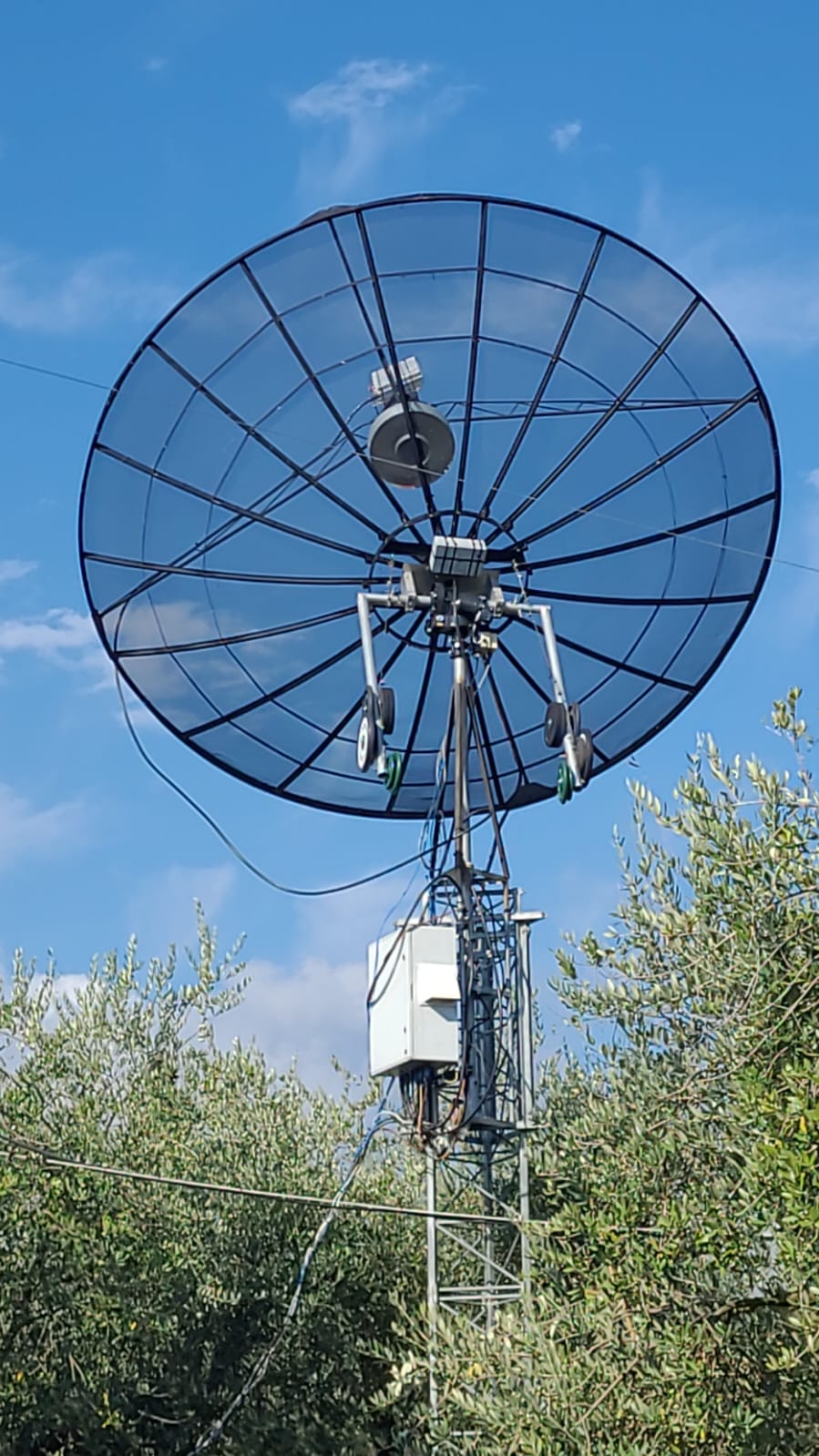 IK2DDR 3.7 m dish OM6AA feed ring
IK2DDR 3.7 m dish OM6AA feed ring
IQ2DB Alessandro
Quite low activity this summer by the AVolta EME Team at IQ2DB; we reached 86 countries thanks to Alex TA/EA8DBM but for a number of circumstances we missed ZA… sometime it happens!
On September 20/21 we took part to the ARI EME Contest with a total of 40 Q65 and 9 CW QSO. Conditions were very bad for our small dish (3 m) especially during Sunday when the sun was 2 degrees from the moon; few QSO in the early morning (6-5 degrees separation) then almost nil the rest of the day (4 to 2 degrees). Our result is in line with the past editions of the contest but we always notice that the participation to this contest, apart from very few stations, is very random; the ARRL and the DUBUS Contest are really much more popular.
K6VHF Alex
On September 14th 2015 at 06:40z I made my first 3 cm EME QSO with Peter OZ1LPR in Q65-60D mode, using a portable station and operated from my backyard. Following setup was used:
- Kuhne Transverter G5
- DL2AM 10 W SSPA (measured 8 W at the feed)
- DEMI LNA (1 dB NF)
- Chaparral Feed
- Bodnar GPSDO
- 60 cm offset dish
- IC-705 IF rig
- WSJT software
This setup is primarily used for terrestrial operations and was not optimized for EME. Earlier that day I measured the sun (2.4 dB) and cold sky-to-ground noise(4 dB). It's lower numbers are lower than VK3UM calculator estimated. Since EME conditions were nearly ideal I decided to try 3 cm EME. System was mounted on on the tripod with manual azimuth and elevation controls with everything warmed up and waiting for the moonrise. For aiming I used an electronic level (elevation) and compass (azimuth). Not good for EME but the only tools I had.
Finally the moon cleared the hills at about 4 deg of elevation and it was time to start. Peter was calling CQ and I was monitoring the band. With Peter's 11 million watts of EIRP the signal should have been visible on the waterfall even on 60 cm dish. Sure enough, after a small elevation adjustment I detected the signal on waterfall, signal was strong and audible but with ... no decodes.
After few suggestions from Peter I synched the PC clock and checked the box for "Decode After EME Delay". Immediately after this I saw first decodes from OZ1LPR. Hooray! Now time to transmit. The estimated EIRP was about 340 W based on antenna gain and 8 W at the feed. Hopefully Peter will decode my signal. Meantime Peter's signal was very consistent at -14 db with best decode of -13. Few minutes later I received RRR and 73. The FIRST 3 cm EME QSO is completed! No big antennas, no heavy high power TWTs, not EME LNA, just ordinary 10 GHz setup.
Time for happy dance and continue building the "real" 3 cm EME station. As right now I’m finishing up my station which includes following:
- Kuhne G4 transverter
- 50 W SSPA
- DU3T Low NF LNA
- 1.2 m offset dish
Meantime I am QRV for 3 cm EME using another "to-go" 3 cm setup based on 76 cm dish and 10 W. Feel free to contact me if anyone wants to try. In the future I am planning on operating on 3 cm / 13 cm / 23 cm from Honduras EK66 grid (HR9).
Thanks to Peter OZ1LPR for amazing QSO and Chuck NJ6D for motivation.
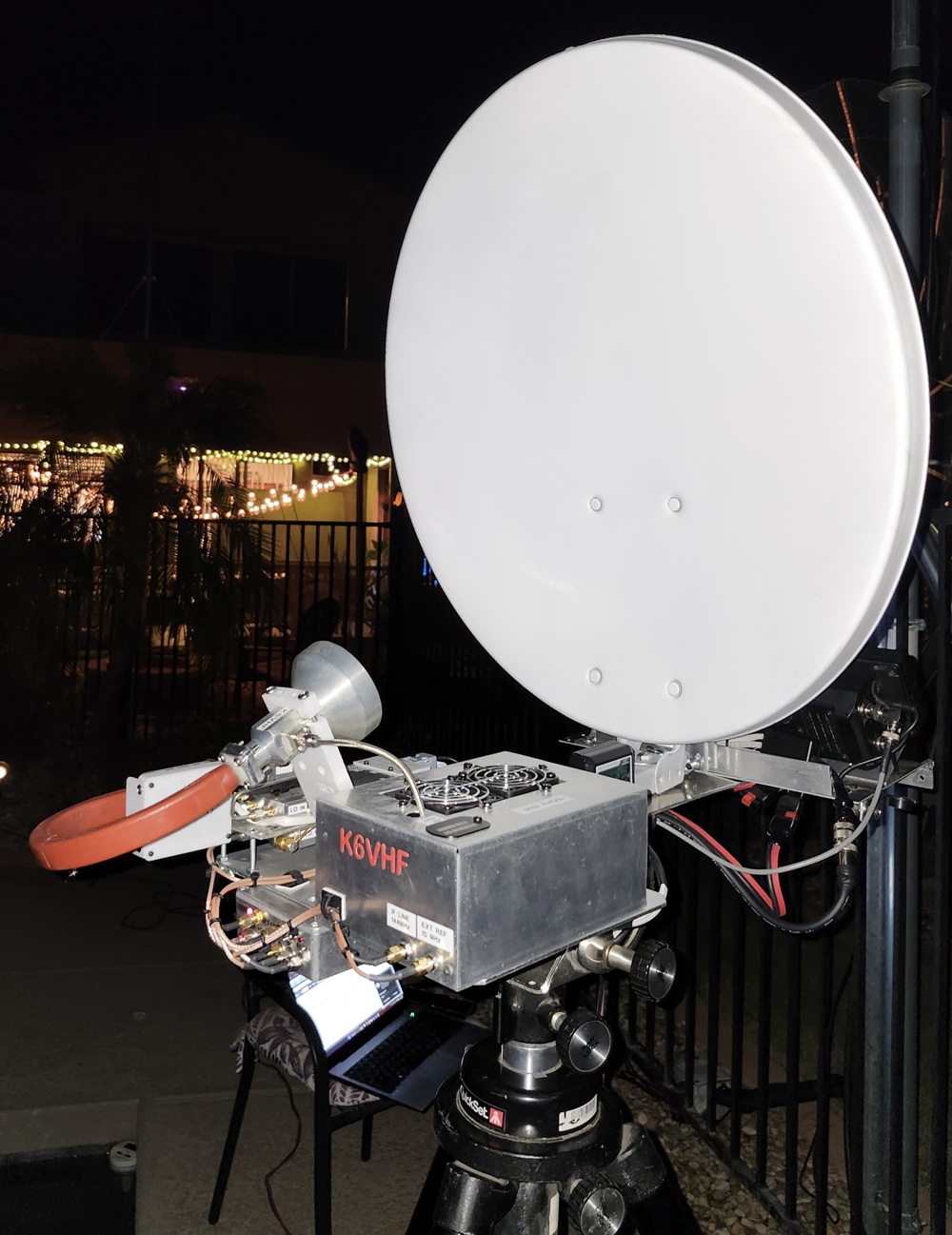 K6VHF portable 3 cm setup
K6VHF portable 3 cm setup
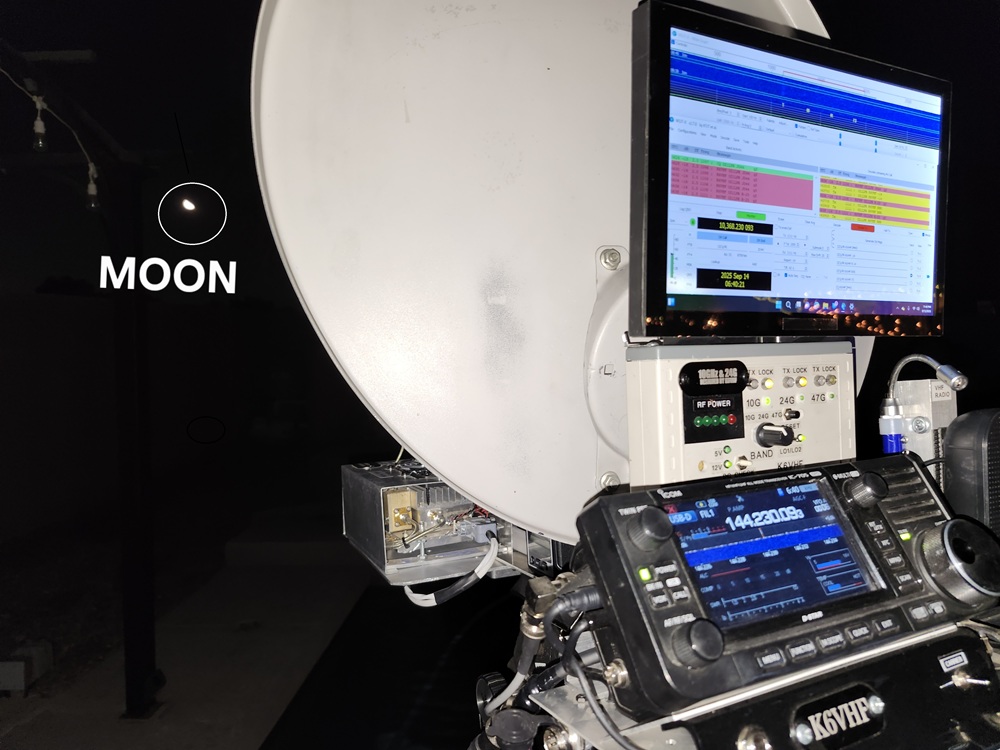 K6VHF 3 cm EME QSO
K6VHF 3 cm EME QSO
KA1GT Bob
A few months ago, I took a small risk and I purchased a low cost 1.5 m "solar cooker", which looked suspiciously like many of the C/Ku band dishes from China. After taking off the reflective coating and mounting it on my Az/El tracking system, I found that I could get around 11 dB sun noise under the same conditions as I saw around 9 dB on my known good 1.2 m dish. So the profile must be accurately parabolic, at least up to 10 GHz. I then built a couple of lightweight stepped septum feeds for 23 cm, and after some tweaking and optimization, I'm seeing around 9 dB sun noise at 23 cm with an SFU around 155. The septum feed has no choke because the additional loss from blockage with the small dish would likely cancel out any improvement in efficiency (and add weight).
Overall, the 1.5 m dish (f/d 0.38) seems to perform about 7.5 dB down on my 3.1 m (f/d 0.34) dish (which is pretty well optimized and used a septum feed with square to round flare and choke). This is quite reasonable since just on the basis of capture area, the 1.5 m dish would be expected to be about 6.5 dB down. The same ~7.5dB difference has been observed on 23 cm QSOs I have made and stations I have monitored simultaneously on both dishes.
More information is at https://bobatkins.com/radio/150cm_EME_dish.html and https://bobatkins.com/radio/lightweight_septum_feed.html
The dish should perform very well on all bands up to 10 Ghz with the right feed. Swiss DXpeditions, such as SV5/HB9COG, have had great success using their own 1.5 m dish and fairly low (100 W) power levels on 23 cm (and other bands up to 10 GHz). So good 1.5 m dish and moderate power is certainly quite a capable EME station on 23 cm EME. The total cost of the dish and feed was around $125 (plus many hours of work!)
This dish design has already been adopted by a number of stations to make EME QSOs on 23 cm and has performed very well. I'm sure there will be reports from them in this newsletter.
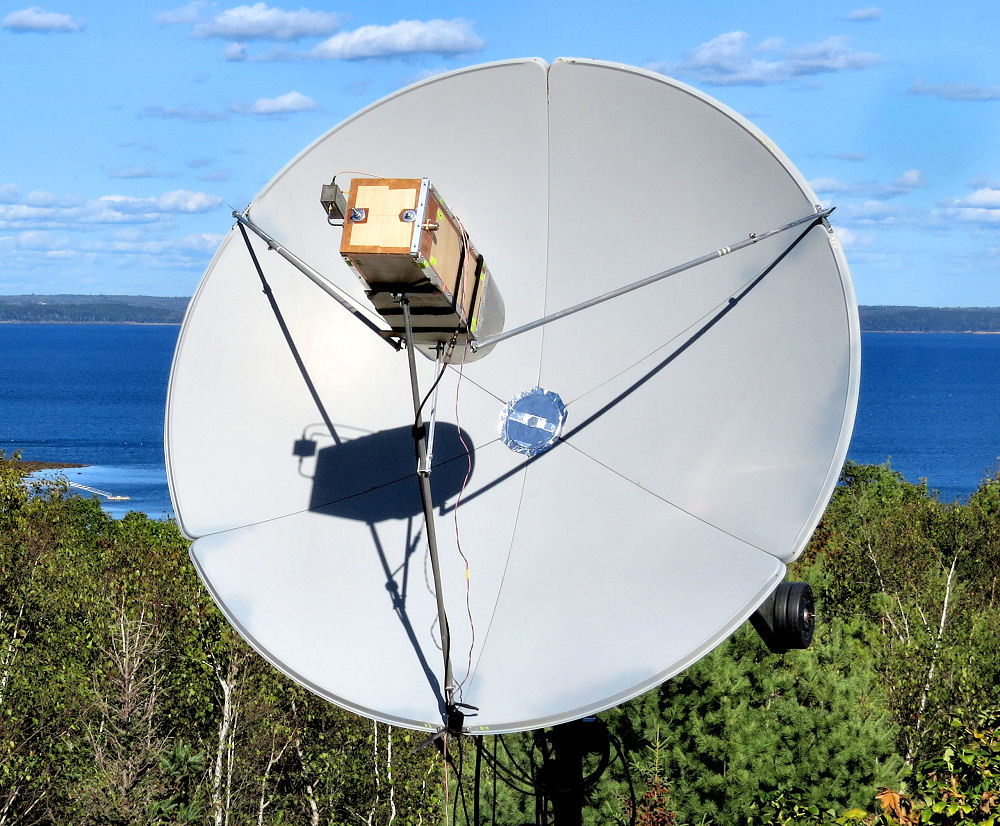 KA1GT 1500 cm dish
KA1GT 1500 cm dish
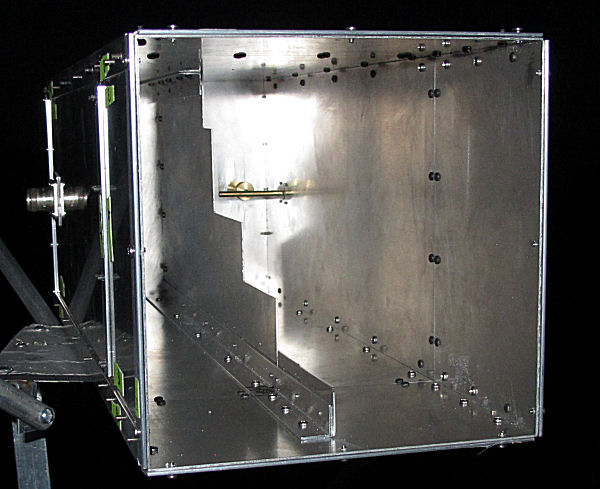 KA1GT feed
KA1GT feed
KB2SA Bill
I have been "contracting" my 1.9 m project to 1.0 m.
I worked with Frank at RFHAMDESIGN to design a custom 1.0 m mesh wire dish with f/D = 0.35. The dish was then mated to a modified square septum feed with a square to 150 mm diameter round opening. This enables a wider pattern to better illuminate the deep dish without choke blockage. Fiberglass struts, polycarbonate strut brackets and dish collar all help lower blockage and sidelobes to help maximize G/T.
Preliminary testing shows S11, S22 and S12 all better than 20 dB. Sun to cold sky is 6 dB @ SFU 153.
My 1st QSO was on July 28th with N5TM's 3.08 M dish. I received Dan -23 dB and Dan reported -19 dB with my 900 W @ feed.
To date, I have over 120 Q65-60C QSOs including OE3JPC (2x56 yagis) and several dishes < 2.0 m including KB7Q and NY1V with the new 1.5 m cooker dishes. QSOs with nearly all 2.4 m folding fabric dishes are possible using Q65-60C, including Alex (EA8DBM) in Latvia (YL) with a -24/-25 report.
1 m dish cold sky to sun on 10 Aug 2025 SFU 153 6 dB NODISK new focus 23 mm inside
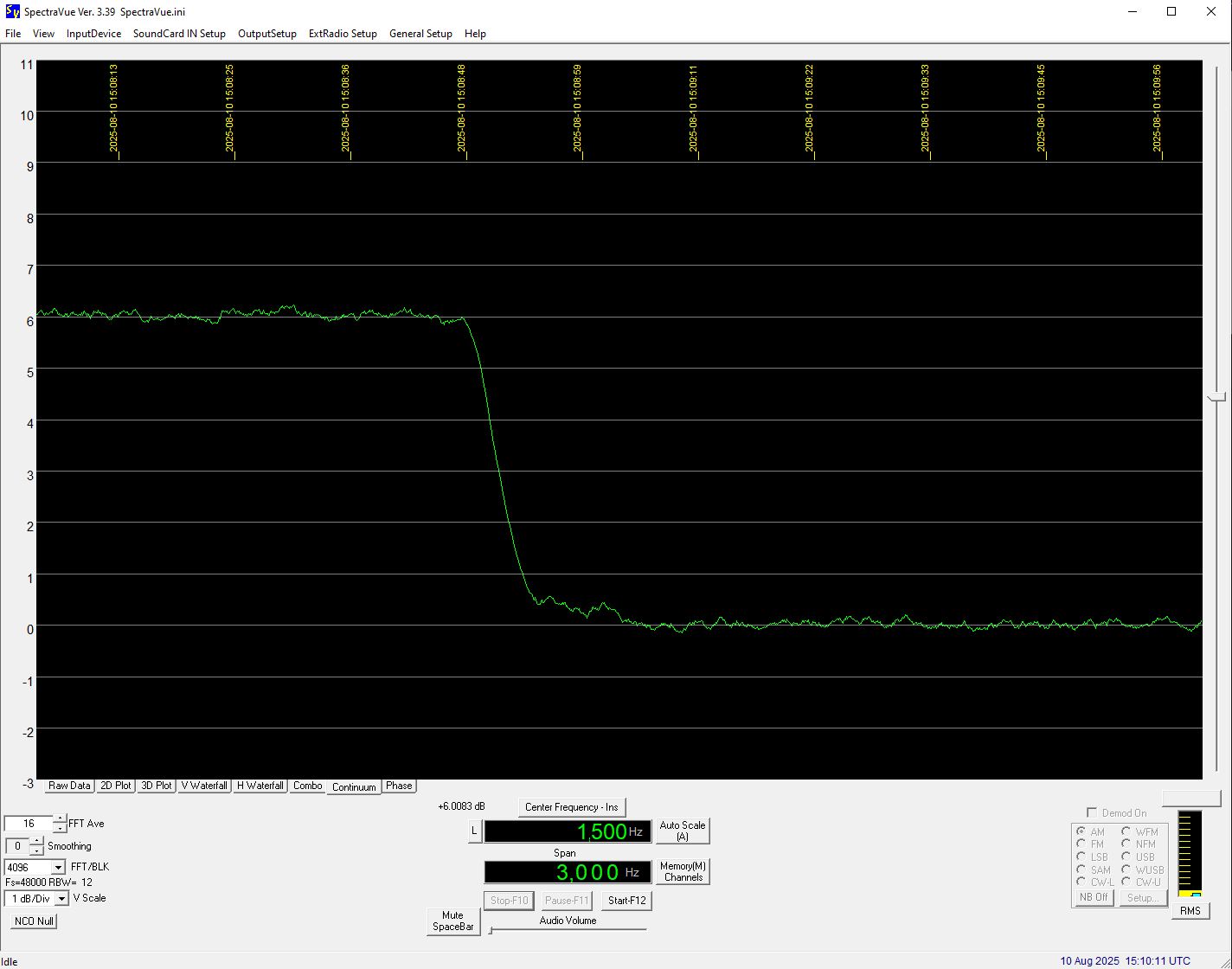 KB2SA 1 m cold to sun
KB2SA 1 m cold to sun
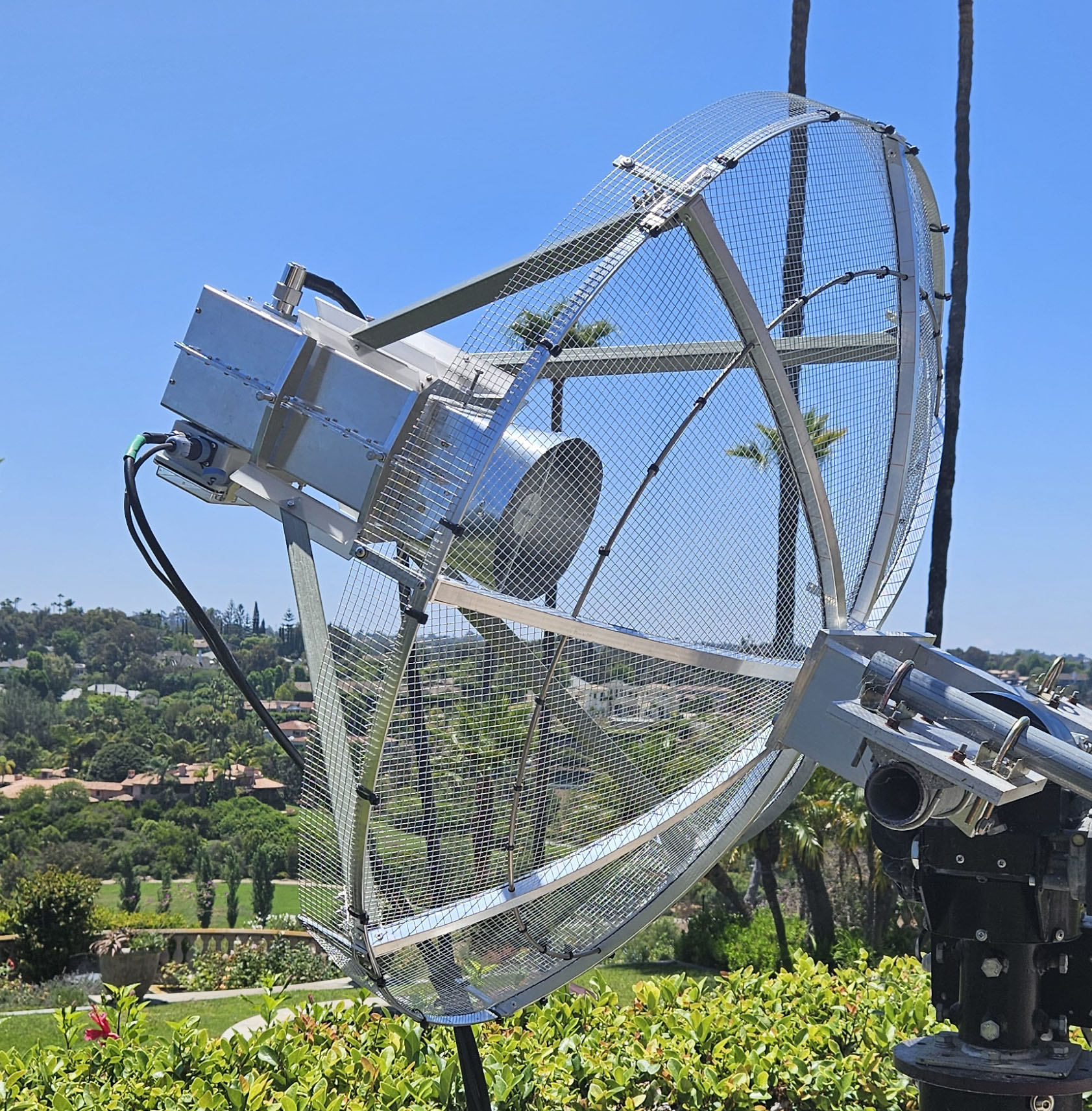 KB2SA 1 m dish
KB2SA 1 m dish
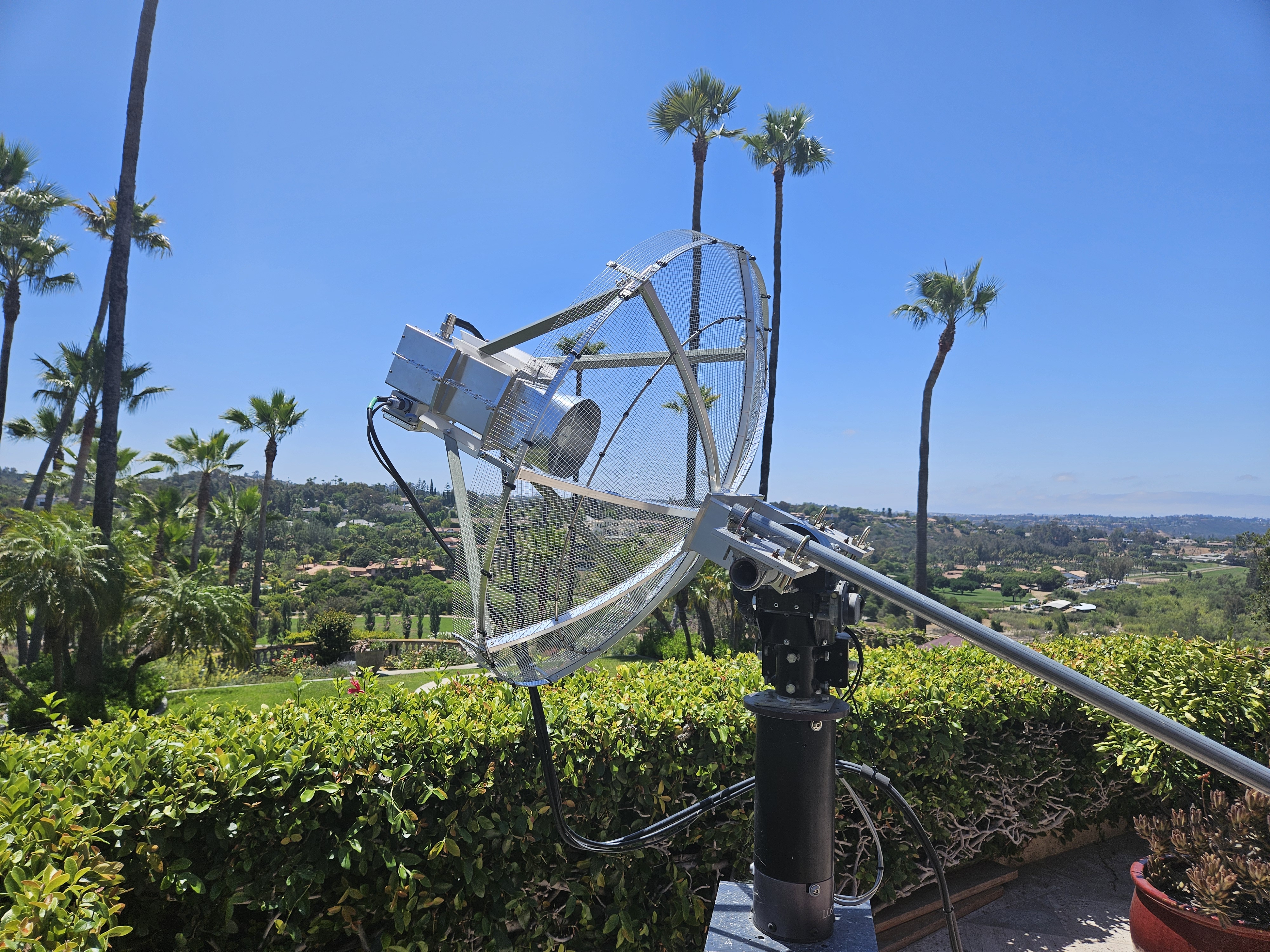 KB2SA 1 m dish full view
KB2SA 1 m dish full view
KB7Q Gene
Late August on into September was productive for me on 23 cm. New stations logged were 9H1BN, OE5JFL, OZ4OC, and intrepid traveler Alex, TA1/EA8DBM.
That brings my station count to 230.
My local machine shop completed the critical piece for mounting for the 1.5 M Chinese "Cooker" dish that KA1GT had discovered to my slew drive. I found the focal point easily with some sun noise measurements (22.375 to 22.500 inches), and ran some extensive tests over several days around September perigee with 10 different stations. I'm seeing 6.5 db sun noise and Bob, KA1GT is seeing 7.5+ dB. The bottom line is that this small six pedal dish has a great profile and works very well for a $100 Amazon item. Who knew!
Some sample contacts:
KB2SA (1.9 M dish 900 watts) heard me from -23 to -19 over ten contacts, we even worked on Q65-15A in a minute. TA1/EA8DBM (much "modified" folding 2.4 M dish 400 watts) was initially heard at -30 dB as the moon was clearing a roof line. We went on to complete at -22/-23 with no hesitation on Q65-60C. Echo testing averages out around -23.5 dB near perigee using 375 watts at the OK1DFC "Lite" septum feed of the "Cooker".
This bargain-basement dish should encourage more folks to join the fun on 23 cm EME and above. I understand that W2HRO is offering ready made mounts for this dish. More details and pictures are on my web site. https://kb7qgrid.blogspot.com/
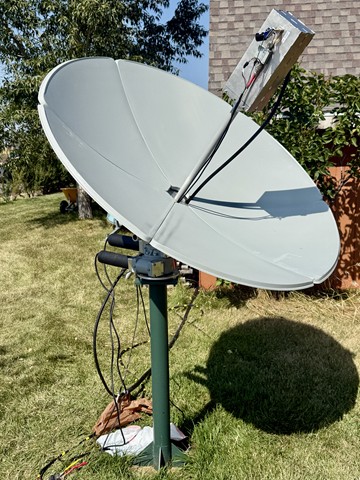 KB7Q testing the 1.5 m solar cooker dish
KB7Q testing the 1.5 m solar cooker dish
NY1V and I completed the first 23 cm solar cooker to solar cooker (1.5 M to 1.5 M dishes) contacts on September 18. Not only did we complete on Q65-60C, but also Q65-30B, and Q65-15A. Degradation was -1.4 db.
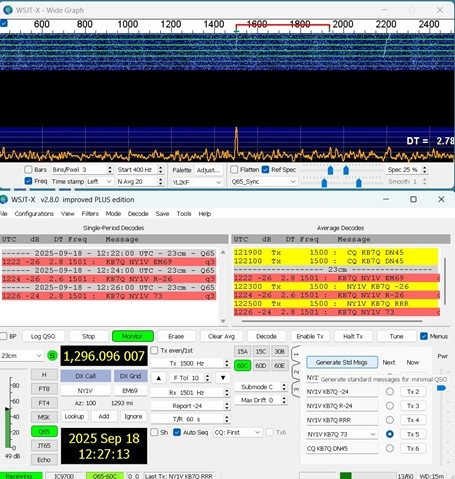 KB7Q NY1V WSJT QSO
KB7Q NY1V WSJT QSO
KN0WS Carl
I participated in the August leg of the ARRL contest from my backyard on 3 cm digital. This would be my first contest to try my dish since refurbishing it this summer. Unfortunately, the weekend was one thunderstorm after another, resulting in 5.8 inches (147 mm) of rain. Lots of dense clouds, wind, rain and lightning. I was able on August 16 in 4+ hours to work OK1DFC(14), OZ1LPR(6), ON5TA(15), OZ1FF(13), KM0T(13), ON4CDU(17), N1AV(15), F2CT(12), DL4DTU(12), I6YPK(20), SA5IKN(21) and OK2AQ(20). On August 17 I had a much more difficult time during my 4 hour window and only worked OH3LWP(17), G4YTL(19), F5JWF(17) and OM4XA(23). One hour I would almost be asking why I still bother with 3 cm, and then the next hour I would work a 1 meter dish or a 0.9 meter dish and everything would feel great!
For the September ARRL leg, I went up north to my EN36 location to use my 4.8 meter dish on 13 cm. My first year on 13 cm was 2017 and I think I had 12 QSOs that contest weekend. At the start of this weekend, my 13 cm initials were only up to 19, which gives you an idea of how often I have been on that band. Last year I did 13 cm the first weekend and everyone else seemed to be on 3 cm - I got only 4 QSOs, so reversing those weekends seems to have worked better this year. My wife and I came down with covid the week before this September contest weekend. I would not have to worry about contagion in my remote location but my energy level was very low.
This would be my first use of this polar dish since I raised one leg by 2 inches and replaced the feed mount struts to accommodate inter-changeable feeds this summer. I figured if I could track on 13 cm, it should do fine with 23 and 70 cm in October. My first 2 cloudy contest hours were met with total failure. It turns out my pointing was still off by almost 2 degrees.
Once that was fixed, I worked OK1KIR(5), G4CCH(7), OK1DFC(10), VE6TA(11) and HB9Q(+1). I had initials with IK3COJ(11), SV3AAF(11), OH3LWP(3), F1RJ(9), K5DOG(22), N1AV(16) and KN2K(17). Emboldened by several signals, I clumsily worked a CW initial with G3LTF, followed by CW QSOs with OK1KIR and G4CCH.
Peter’s was only my 2nd CW QSO on this band - the first was in 2017. I tore down camp after the first moon-pass and drove home. I did not have the energy to set up my backyard gear for 3, 6 or 9 cm. Instead, I slept for 13 hours! I hope to use the ARI contest next week to test out my newly-interchangeable 23 and 70 cm feeds on the 4.8 meter dish, but reports suggest it is to be yet another rainy weekend - of course. (ARRL totals: 16 on 3 cm and 13 on 13 cm).
N1AV Jay
Now that the first two weekends of the ARRL EME contest are over, I can reflect a bit on my 2304 and 10G station.
First off, for the US stations that are thinking about getting on 13 cm but can't get their head around how do you take into account the majority of EUs on 2320, while US is on 2304. The newest RC1 version of wsjt-x as well as the previous (and now new) version of WSJT-x Improved SOLVES this problem. There is a setting that allows for TX offset at the bottom of the astronomical window.
Set the radio to 2320.xxx. Select a -16 MHz offset and you TX at 2304.xxx. Nice! Yes, you still need an IF that can handle those frequencies, however, it is a great solution built right into the software. Please reach out to me if you want more info on how I do it. (99% of 2304 MHz rxs have a 2320 MHz signal coming out of the IF port 16 MHz HF, i.e. 160MHz - Ed)
For the contest, 13 cm participation in the US was very low. Hey America! Let's change that for next year - OK all? I know several of us were having RX issues (myself included) but I managed to work 21 stations on 13 cm while missing 4. I did see several EU stations drop off the chat pages even before I had moon, so that was frustrating. I guess I need to start emailing stations directly to ask them to stay on longer.
10G was a massive improvement from the year before when I only ended up with 3 stations worked. The system worked very well for the entire weekend. Not perfect, but very well. Very happy with the results, having worked 51 and only missed 3. Due to some personal family conflicts and trips to GW, GM and G lands, I was not 100% in "contest mindset" for these first two weekends, but I was happy with the results nonetheless. Thank you everyone who was on 10G. I picked up a few new DXCC and several new grids as well, so that was a great addition. It is amazing to see the waterfall as alive on 10G as I see on 1296 at times - Great effort all!
For the 222 and 902 EME ops, don't forget - our activity pass will be the last pass of the contest, Sat, Nov 8th.
UPDATE: HAWAII 2026 5 GHz & 10G EME Expedition may get pushed to 2027. We are having some scheduling difficulties. We will have 1.5 m dish and 40 w on 5 GHz and 1.5 m dish and at least 25 w on 10G. Question: What is the interest level in 3 GHz EME from KH6? It means a lot more gear, but if there is enough interest it could be possible. Please contact me directly with interest levels.
Onwards to the 1296 and below weekends! Looking forward to seeing you all on the moon on 1296 MHz and below!
NC1I Frank
I have not been very active over the last few months. Hopefully that will change for the fall.
Since mid-June I have added the following initials on 70 cm:
On 25 July DL0IN (1 x 8-elements and 60-watts). On 16 August LZ1CWK (1 x 13-elements and 30-watts). On 17 August VE3EFF (2 x 23-elements and 70-watts). On 8 September WI0JK (1 x 9wl and 75-watts). On 13 September RD3FD in a new grid (LO05), (4 x 14-elements and 500-watts).
Since mid-June I have added the following initials on 23 cm:
On 21 June 3A2EME for a new DXCC and YU1DA (3.05-meter and 250-watts). On 18 August OH0/EA8DBM for a new DXCC. On 19 August GW4ZHI (2.4-meter and 100-watts) for a new DXCC. On 20 August YL/EA8DBM for a new DXCC. On 11 September TA1/EA8DBM for a new DXCC. On 14 September ZA/LY3UM for a new DXCC. And finally, on 15 September PA2GWA (3-meter and 100-watts).
Thanks to Alex EA8DBM for five new DXCC entities and Bryn for a new DXCC entity. I continue to be amazed with what Alex has been able to do, especially considering he is a one-man operation. He has provided so many new DXCC contacts and spiked activity on 23 cm (and 13 cm). He has overcome so many problems and always seems to find solutions for whatever problems and issues that arise. Thanks Alex!!
Another recent highlight was a contact on 15 September with Jac PA3DZL. Jac was using a double quad antenna with just 7 dB gain and only 100-watts at the antenna. His best was -26! It is amazing what Jac has been able to do with such a small antenna.
NY1V Rick
I obtained one of the 1.5 M solar cooker dishes and the mount from W2HRO and installed it on September 17th. My station includes Icom 9700, 1.5 M Cooker dish, the OK1DFC light weight septum, AGO preamp, and PQL amplifier. I have successfully completed 39 EME QSOs with the "cooker dish" including 1.5 M to 1 M QSO with Bill KB2SA, and 1.5 M to 1.5 M cooker QSOs with Gene KB7Q. Gene and I were able to complete Q65-60C, 30B, and with some repeats 15A.
OH3LWP Ari
My main activity in ARRL EME contest September 13-14 was on 3 cm and 13 cm bands (same as in August). I worked a few stations on 6 cm band as well and was delighted to work also some QSOs on the 9 cm band. I worked the following in ARRL EME contest 2.3 GHz & Up 2nd weekend:
10 GHz:
13/9/2025 F6BKB, IK6CAK, W3TI, IK0HWJ, OZ7Z, N2END, PE1CKK, OH2DG, NJ6D, IK3GHY, KL6M all digital
14/9/2025 VK7ZBX, VK4WYM all digital
5 GHz:
13/9/2025 UA3PTW, OK1DFC, SV3AAF all digital
14/9/2025 OH1LRY digital, OH2DG digital, G3LTF CW
3.4 GHz:
14/9/2025 G4CCH, DF3RU, OK1DFC all digital
2.3 GHz:
13/9/2025 OM0MS, OK1DFC, F1RJ, KN2K, KN0WS, VE6TA, OK1USW, N0ACK, SV3AAF, K5DOG, IK3COJ all digital
14/9/2025 W5LUA digital
Outside the ARRL EME contest, highlights were expeditions to TA/ZA. On 1.3 GHz completed digital QSOs with TA1/EA8DBM but I missed ZA on 1.3 GHz due to activity at the same time in ARRL EME contest.
OK1DFC Zdenek
For the second round of the EME ARRL MW contest 2025, I prepared the 9 cm band in addition to the bands from the first round. I assumed that since no one appeared on 9 cm in the first round, there would be a lot of activity in the second round. The opposite was true. The 3400 MHz band is on the decline, as it is gradually being taken over by professional services around the world, and with the emergence of interference from professional services, amateurs are gradually withdrawing. In the end, I only made three QSOs.
For the contest, I again chose a strategy of two bands simultaneously, with 13 cm permanently installed in the large dish and changing bands in the small dish according to activity. Today, after automating everything, the transition from band to band takes 10 minutes. Thanks to the fact that it is an offset dish, there is no risk of falling off the ladder at night when changing bands in a hurry. I don't know how many times I changed everything, it could be calculated from the log, but sometimes I didn't make any new QSO when changing bands, so it wouldn't correspond to reality anyway. The greatest activity was in the 3 cm band. This time, I also managed to connect with two VK stations. Again, I managed to get several new initials and, by connecting with KL6M, a new country #48 DXCC. Unfortunately, JA on 3 cm was empty again.
On 6 cm, I made room for myself by transmitting in the direction of the local WiFi network point all Friday, so this time there was no QRM. I also made 6 QSOs and a new initial. One JA station appeared on 6 cm, which surprised me quite a bit, as it called me on my call CQ. This time, I was finally able to measure the moon noise, and I was satisfied with the value of 1.2 dB.
On 13 cm, I was still waiting for Alex to appear as ZA/LY3UM, but unfortunately his SSPA failed, so there was no new country in the 2320 MHz band. However, I made several new stations from the USA and ended up with 15 QSOs in the 13 cm band. Apart from SP6JLW and WA6PY, I made everything that was available on the band during both rounds. I did also work Alex ZA/LY3UM on 23 cm on 13th September for DXCC#143.
Overall, I finished both rounds of the MW section with a score of 102 QSOs. Multipliers I still have to count.
Round 2 2025
15x - 13 cm
3x - 9 cm
6x - 6 cm
14x - 3 cm
In 2024, I had a total of 85 QSOs. So, let's see what the October and November rounds bring, when 50-1296 MHz will be used. I look forward to hearing from you. Finally, here is my log.
13 cm: OM0MS, OH3LWP, KN0WS, F1RJ, KN2K, OK1USW, SP3XBO, NOAKC, VE6TA, IW2FZR*, K5DOG, HB9Q, WA3RGQ, W5LUA, N6NU. (15 QSOs)
9 cm: OH3LWP, G4CCH, DF3RU* (3 QSOs)
6 cm: OH3LWP, UA3PTW, SP6JLW, BA7NQ #35 DXCC, JS6UJS, OH1LRY (6 QSOs)
3 cm: F6BKB, BD3SY, VE4MA, PA3CSG, KL6M #48 DXCC, PA0PLY, SA6BUN, OH1LRY, VK4WYM, IW2BNA, LZ4OC, IK3GHY, OZ7Z, VK7ZBX (14 QSOs)
ON4CDU Hans
September 10 GHz activity using 1.2 m dish with 30 W output.
13/9: W3SZ, KM0T, SA5IKN, PE1CKK, IK6CAK, DJ7FJ, SO5AZ, VE4MA, N1AV, OM4XA, PA0PLY, KL6M
14/9: OK2AQ, SA6BUN, IW2FZR, IK3GHY, F5JWF, OK1DFC
19/9: IW2BNA, YO2LAM
21/9: OZ1LPR
OZ1FF Kjeld
Here is my report from the ARRL EME MW Contest 2025:
I participated in both legs of the ARRL EME MW Contest 2025 on 10 GHz. There were favorable conditions and good activity. I worked in Q65/CW the following stations:
1st leg: F2CT, OZ1LPR, YO2LAM, ON5TA, YO8RHI, OK1DFC, UN6PD, DJ7FJ, SQ9ATC, G8RWG, OM4XA, LZ4OC, DL4DTU, IW2FZR, G4HSK, SO5AZ, OH3LWP, ON4CDU, SA5IKN, KM0T, N1AV, WA3GFZ, W3SZ, OK2AQ, HB9Q, F5JWF, PE1MMP, N2END, IK0HWJ, IK6CAK, KN0WS, I6YPK, G4BAO, K5DOG, IW2BNA, G4YTL, PE9GHZ, OH1LRY, PA3CSG, VE6TA, CX2SC.
2nd leg: F6BKB, BD4SY, GW3TKH, OH2DG, W3TI, OZ7Z, PE1CKK, PA0PLY, VE4MA, KL6M, SA6BUN, NJ6D, IK3GHY, PA7JB, HB9BBD.
Total 56 QSOs and 47 multipliers.
PA0PLY Jan
I worked on 10 Ghz for both the ARRL and ARI contests. In the ARRL I had 37 QSOs all Digital with 4 # initials: SA5IKN -16/-14 0.9 m dish / 27 W, W3TI -18/-16 1.2 m dish / 20 W, KL6M -16/-16 9.5 m dish / 30 W (under illuminated), IK3GHY -12/-11 1.8 m dish / 40 W. I initially tried with Mike KL6M in CW, but the spreading made decoding almost impossible. Funny enough his Q65 signals were very straight and solid. In ARI contest I had a total of 20 QSOs with 3 in CW and 1 # initial - PA0JCA -16/-16 1.8 m dish / 20 W. At moonrise I worked VK7ZBX and VK4WYM just on the end of our moon window. Signals during the ARRL were much stronger then during the ARI contest.
In between the contest dates I worked IZ0JNY. Ivan used a 1 m dish and 20 W. During this QSO is was really windy and the moonnoise was shaking up and down by almost 1 dB.
Next to my transverter and TS2000, I added a splitter on 10 GHz and connected a Bullseye LNC routed to two dongles. One for I0NAA Total power and the other is connected to SDRConsole and Qmap. With this setup it is easy to monitor the band and tracking. On September 22th I was at PI9RD to do some repair work. We now have the 3400 MHz operational with approx 50 Watt at the antenna. The following bands can be activated now at any moment: 432 MHz, 1296 MHz, 2320 MHz and 3400 MHz.
PA3DZL Jac
My 432 MHz activity started on the 24th of Aug, YB2MDU # and new DXCC very nice surprise to QSO with Bint running 4.5 m dish and abt 50 W, GØJDL, IZ6MVK and YO2NAA.
On 1296 MHz activity there was very nice activity from Alex EA8DBM/LY3UM from rare DXCCs, LY3UM #, AC2AC, DM9LSB, YU1DA #, ZA/LY3UM # and new DXCC, TA1/EA8DBM # and new DXCC, WA4LM #, N5TM, KA1GT, MØLNB, LU8ENU, R1NW, ZA/LY3UM #.
On 2320 Mhz my activity was good, I worked: IK3COJ, SP3XBO, NØAKC X-band, IW2FZR, OK1USW X-band, W5LUA X-band. During the ARI contest: wkd IK3COJ 1 x CW and 1 x Digital which is allowable within the ARI rules.
PI9RD - Jan PA3FXB
23 cm SSTV EME moon landing party on August 23.
Since 2019, when it was 50 years ago that we saw the first man on the moon, we at PI9RD do a 23 cm SSTV EME moon landing party. We try to do that close to July 20/21 of course. That’s not always possible because of moon availability, agenda problems or other reasons. This year we were more than one month late and that was because of technical problems… We found that there was water in the oil of the azimuth gearboxes of the big dish. Because this oil is constantly pumped on the cogwheels the oil quickly turned into a kind of ‘mayonnaise’ and lost its lubrication properties. So, we had to stop moving the dish. It took a few weeks to solve the problem. Taking out hundreds of litres of mayonnaise, cleaning the gearboxes and filling them up with new, fresh and clean oil took some time…
Anyway, everything was up and running in the week before August 23, so we decided to do the postponed party on Saturday August 23. There was one extra challenge that day: The sun was very close to the moon. Our big dish has a 0.5-degree beamwidth so for us it was not a problem but for smaller dishes this would be a problem. But moon bouncers like a challenge so we thought this might be a great opportunity to learn something about your sidelobes 😊
It appeared that quite some stations liked the challenge as we saw at least 17 stations trying to receive and decode our SSTV signals. And some of them sent SSTV to us too. So, many thanks to: N5TM, KB2SA, DL0SHF, IZ5TEP, IK1FJI, CT1FGW, OH3LWP, AC2AC, G0HIK, YU1DA, ON4BCB, W2HRO, K0DSP, G4CCH, XE1XA, OH1LRY and AG7CM.
As expected, we received the same quality images as we always do. We had no extra noise from the sun. For the others it was much more difficult than normally because they all experienced more noise because of the sun being so close. Still some very good quality images were received! So, the sun made it more difficult but did not spoil the party completely 😊
Thanks to all who participated in the party! It was big fun!
Next EME SSTV event will be the traditional ‘end of the year’ party. We intend to do that on Saturday December 27 this year.
These pictures were received by CT1FGW. The lady in the picture is Vera Rubin, the famous astronomer (1928 - 2016). This year the Vera Rubin observatory in Chile started operations so we thought it was nice to honour Vera by sending her picture to the moon.
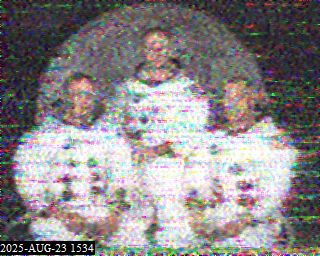 PI9RD rx by CT1FGW image 1
PI9RD rx by CT1FGW image 1
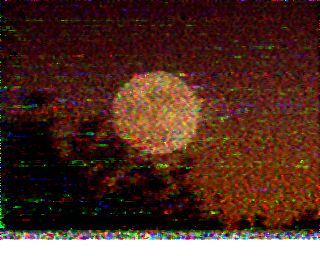 PI9RD rx by CT1FGW image 2
PI9RD rx by CT1FGW image 2
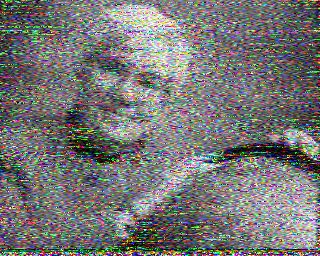 PI9RD rx by CT1FGW image 3 Vera Rubin
PI9RD rx by CT1FGW image 3 Vera Rubin
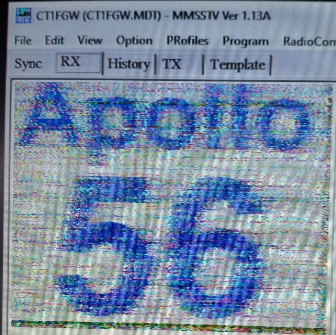 PI9RD rx by CT1FGW image 4
PI9RD rx by CT1FGW image 4
With DL0SHF we had a complete SSTV QSO 😊
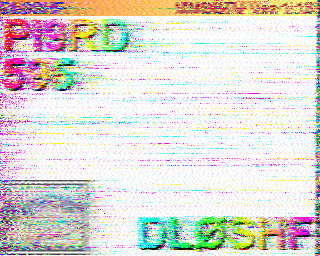 tx by DL0SHF rx by PI9RD
tx by DL0SHF rx by PI9RD
These were received by G4CCH
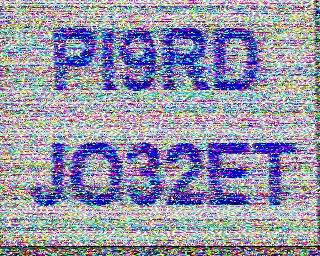 PI9RD rx by G4CCH image 1
PI9RD rx by G4CCH image 1
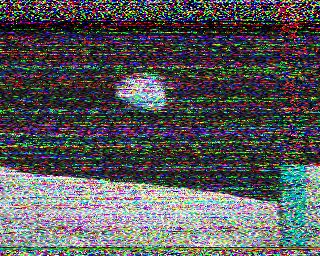 PI9RD rx by G4CCH image 2
PI9RD rx by G4CCH image 2
And this one we received from XE1XA:
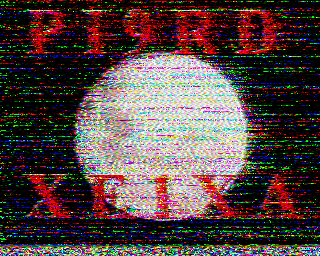 tx by XE1XA rx by PI9RD
tx by XE1XA rx by PI9RD
SA5IKN Max
August and September proved to be productive months for me, both in terms of the number of QSOs and in the variety of unusual contacts. I was very active with my portable 10 GHz EME station, operating both in the field and from home, in the latter case even from a balcony. My station consists of a 0.9 m dish, 27 W SSPA, 0.6 dB NF LNA, and real-time spatial polarisation offset tracking integrated with EME Observer.
ARRL EME Contest
I took part in both legs of the ARRL EME Contest, operating fully portable. Across three sessions of approximately four hours each, limited by battery capacity, I logged 40 QSOs in 18 DXCCs, including 4 dupes. Despite the small size of my station, most QSOs were completed with ease, and on several occasions I even experienced mini-pileups, with three or four stations calling me simultaneously. The only two stations I was unable to complete with were Petros SV3AAF and Ric CX2SC. The weather during the contest was pleasant, and so too were the lunar libration and the resulting Doppler spread.
SA5IKN portable battery-powered 10 GHz setup during the ARRL EME contest:
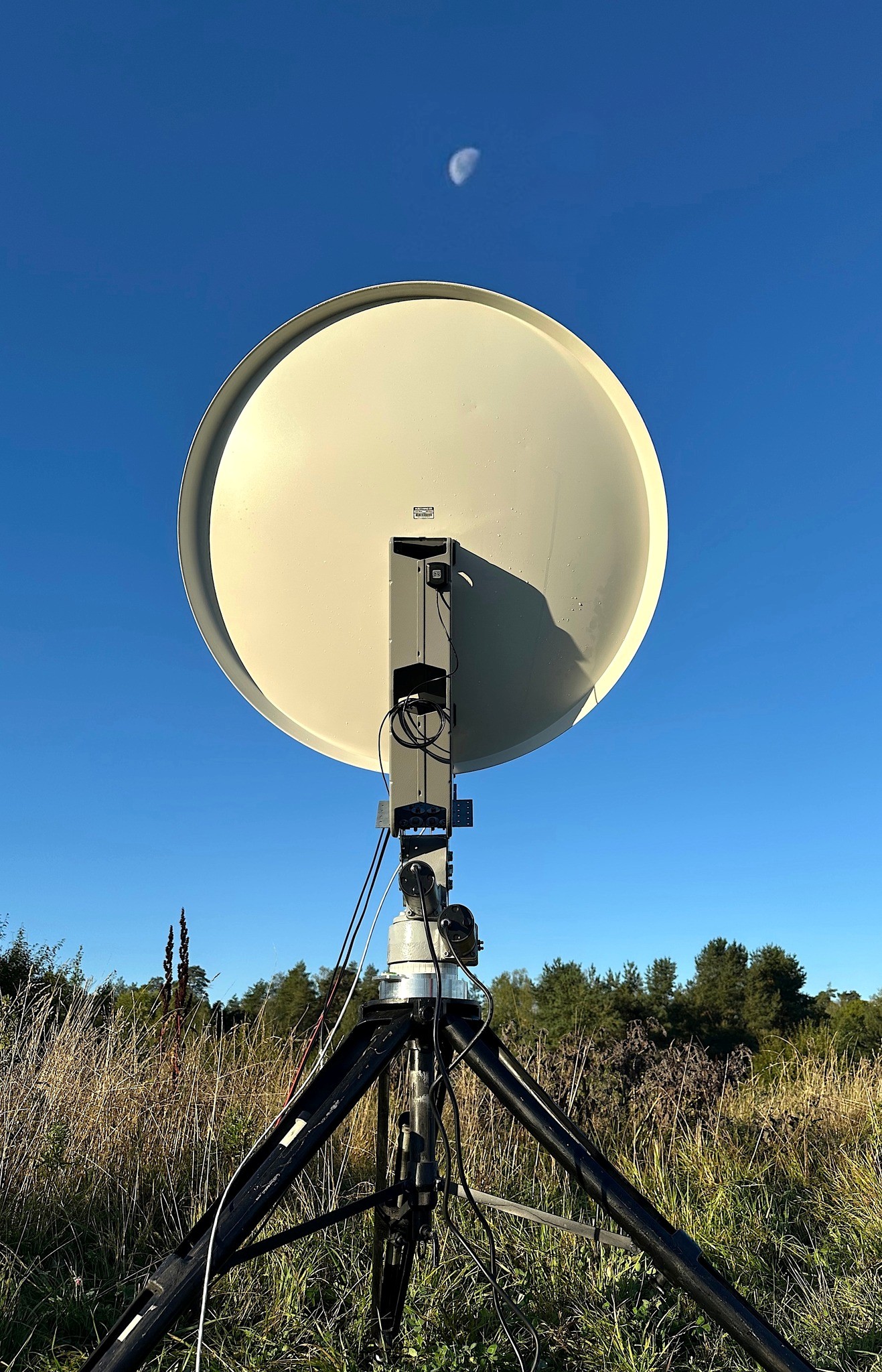 SA5IKN portable 10 GHz setup
SA5IKN portable 10 GHz setup
ARI EME Trophy
I participated in the ARI Contest, first operating portable on Saturday for only three hours and later adding a couple more contacts from my balcony, bringing the total to 11 QSOs. Conditions were far less favourable than during the ARRL Contest. The weather was rainy and windy, and my XYL and I had to set up a tent. The spread was also much worse. The highlight of this contest was a QSO with Richard VK7ZBX, with good reports despite the challenges.
SA5IKN portable batter-powered 10 GHz setup during ARI EME Trophy
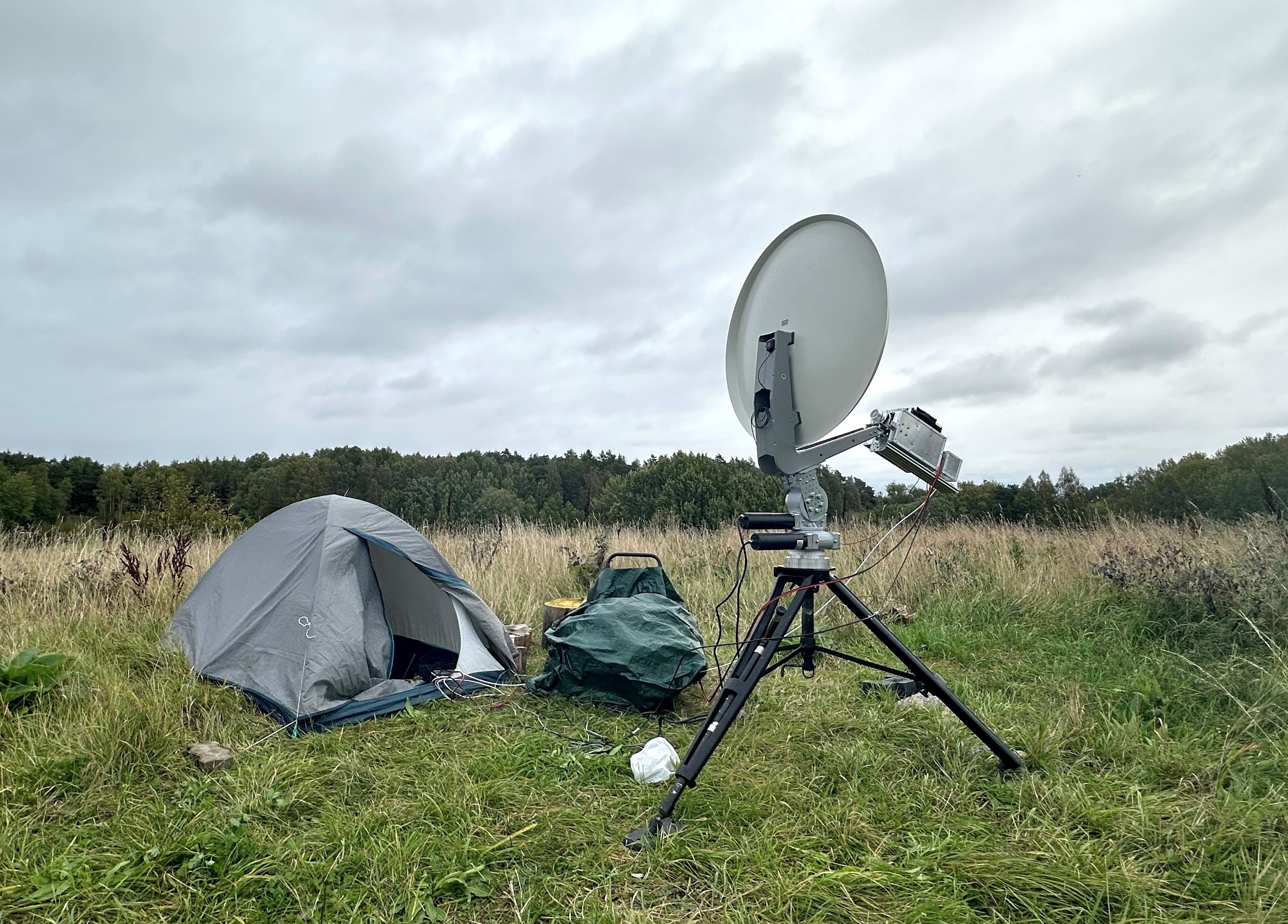 SA5IKN ARI EME portable 10 GHz
SA5IKN ARI EME portable 10 GHz
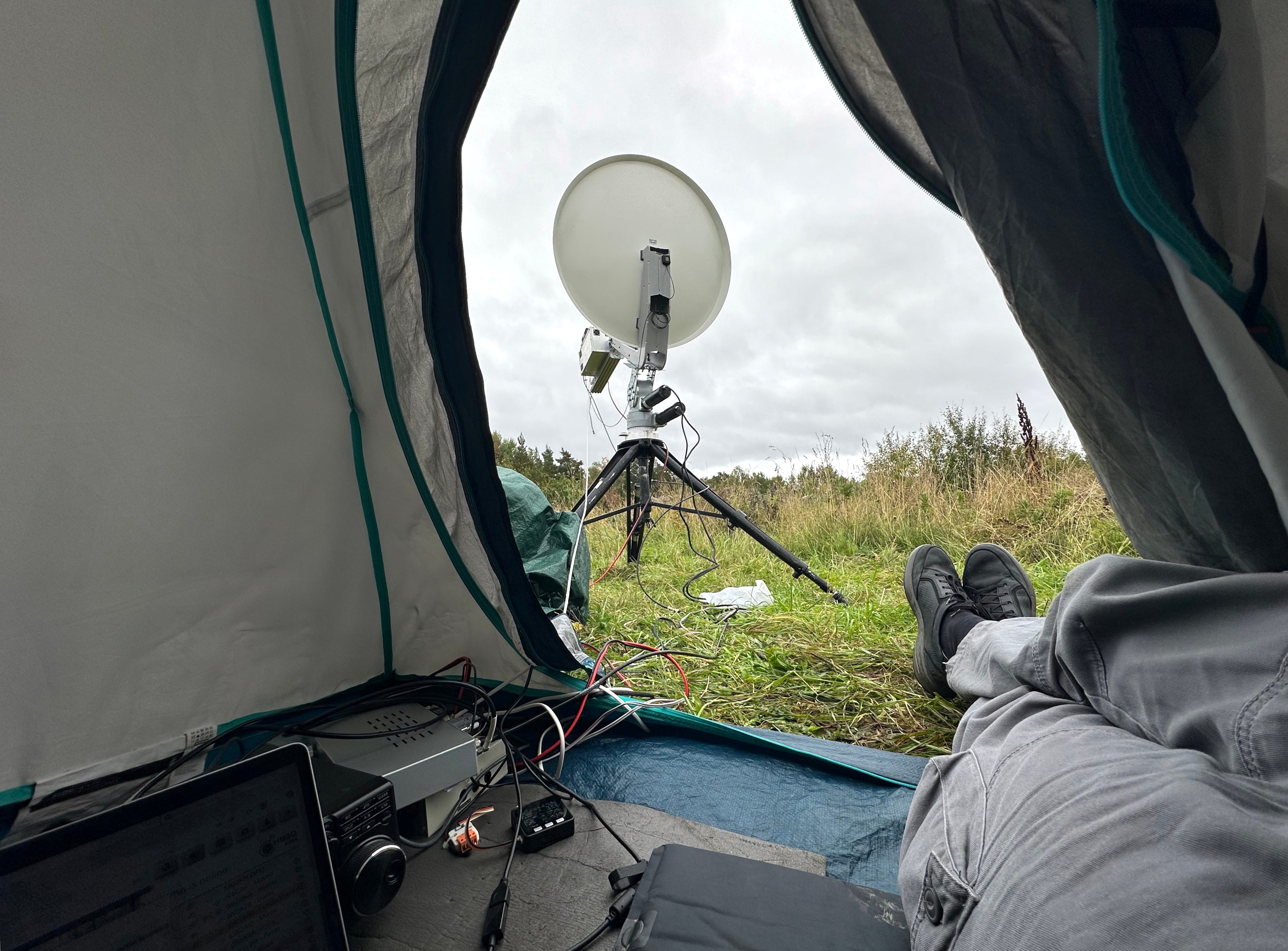 SA5IKN ARI EME portable 10 GHz inside tent
SA5IKN ARI EME portable 10 GHz inside tent
Balcony-to-Balcony QSO
Another memorable event was an unusual 10 GHz EME QSO with Bruno, I6YPK (1 m dish / 25 W). This contact was remarkable not only because of the very small stations involved (0.9 m - 1 m dishes), but also due to the circumstances: both antennas were operating from balconies with restricted sky visibility.
Bruno’s dish was mounted outdoors on balcony railings with a reasonably clear takeoff to the Moon. My setup was entirely indoors on a glazed balcony, transmitting through an open window. Despite these constraints, the QSO was successful. On my side, averaging was required to complete the contact, and I suspect that scattering and reflections cost me a dB or two. When portable, my system generally performs much better (as many of you witnessed during the ARRL contest), and I believe that outdoors this QSO could have been completed without averaging.
Bruno’s station is well optimised, and he had previously worked Ivan, IZ0JNY, who also operates a 1 m dish. Our QSO took place immediately after my random contact with Hans, ON4CDU, who uses a relatively small 1.2 m dish.
When I designed my 0.9 m / 27 W portable station, my aim was to build a system capable of working its “twin" under normal conditions. This QSO confirms that the design target has been met, with performance closely aligned with theoretical predictions. If anyone is operating an optimised station with a dish smaller than 90 cm, I would be very keen to attempt a QSO with you. The next challenge awaits. More details, photos, and updates are available on my website: https://dxer.site
SA5IKN portable setup on a glazed balcony and I6YPK balcony setup for 10 GHz EME
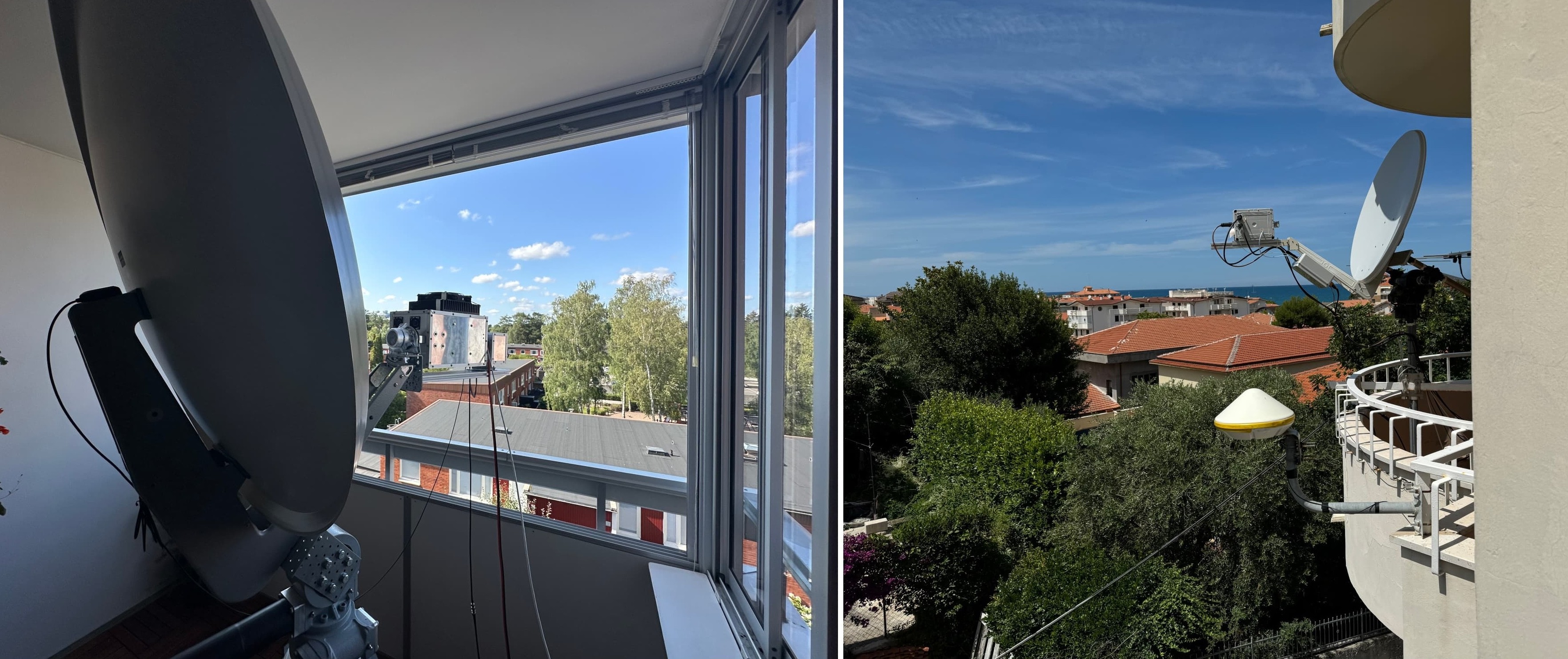 SA5IKN and I6YPK balcony setup
SA5IKN and I6YPK balcony setup
0.9 m to 1 m balcony-to-balcony QSO screen shot from SA5IKN (top) and I6YPK (bottom)
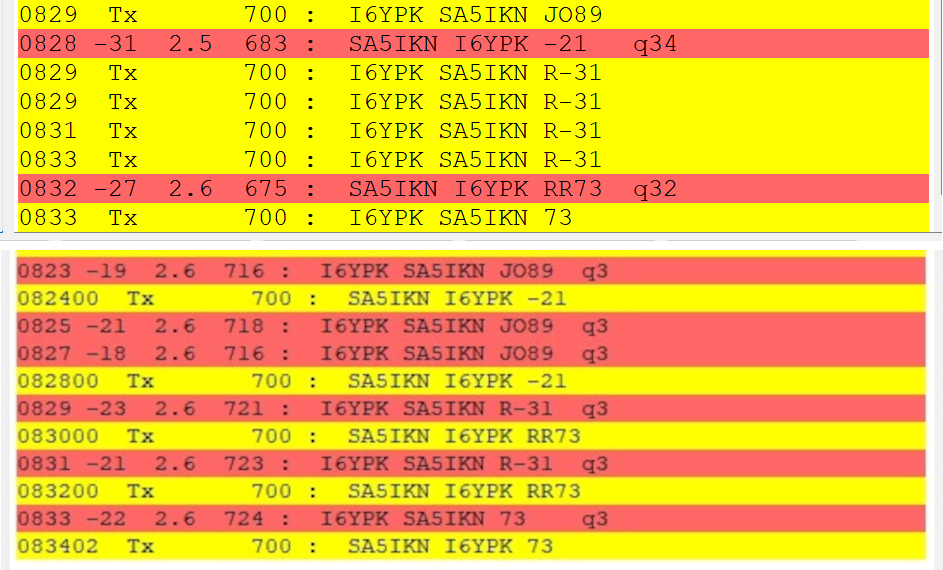 SA5IKN I6YPK WSJT QSO
SA5IKN I6YPK WSJT QSO
VE4MA Barry
I have not been operating much this summer as I have been working toward and waiting for the opportunity to operate on 47 GHz EME. Unfortunately either the weather has been bad in EU or here in VE4. I did want to participate in the August weekend of the ARRL “2.3 GHz & Up” EME contest, but the ARRL also scheduled a terrestrial microwave contest for the same weekend. I was coordinating local microwave activity and provided with 4 “loaner” 10 GHz rigs and operated up to 122 GHz I can still operate all night, but not all night and all day for 2 days!
I did operate on 10 GHz for the September 13/14 ARRL contest and QSO’d 34 stations including many 1.2 m dish systems. I was pleased to work KL6M again, this time with much better signals.
Pending any possible 47 GHz EME activity I expect to be active during the next round of the ARRL EME contest on 70 cm, as VE4SA who lives less than 1 km from me, will be active on 23 cm.
VK7ZBX Richard
Last weekend I was able to spend 1 day in the ARRL EME contest on 10 GHz. I was able to work Zdenek OK1DFC -10/-15, Ari OH3LWP -16/-22, Guy F2CT -13/-18, Zhu BD4SY -18/-19, and Peter OZ1LPR -7/-15.
This weekend I gave the ARI EME contest a go. Managed to work the following stations Bata YO2LAM -10/-21, Jan PA0PLY -15/-17, Mirek OK2AQ -13/-17, Peter OZ1LPR -2/-16, Max SA5IKN -22/-21, Fero OM4XA -20/-17, Dario IW2FZR -16/-18, Walter IW2BNA -18/-19, Mauro IK6CAK -15/-20. Bata, Max and Fero are new initials which is fantastic. Stand out contact was with Max SA5IKN who went portable and once he was set up it rained and was windy so he was in and out of a tent and waterproofing everything. A great effort.
My quite small system seemed to work quite well. 1.8 M PF dish, 20 W SSPA, Kuhne G4, IC9700. Tracking by RazTrak.
Thanks to everyone for the contacts.
W2LPL Les
Summer vegetation has limited my activity on 1296 since April, but was able to catch some moon time between the tree branches in September. Seeing nice improvements due to the OK1DFC shortened Septum and a more optimized (shorter) Focal Length with Echos of -23/-22.5. Now easily able to work other 2.4 M folding dish stations including NY1V(-23), WA4LM (-19), KG0D (-21) Yagi, OE3JPC (-25) and even KB7Q's 1.5 M modified Solar Cooker (-25). And that's with tree branches and leaves still blocking the edges of the dish and raising my noise level. I think we will be seeing more and more of these 1.5 M dishes as it significantly reduces the cost barrier with acceptable performance.
W2ZQ - Paul W2HRO
Delaware Valley Radio Association (DVRA) in New Jersey, USA, is building a 2nd dish for EME operations. The first dish installed is a 3 M aluminum mesh with a 500 W amp, and it has been used with good 1296 MHz results in the past three ARRL EME contests. The new dish is a 4.6 m solid aluminum dish that was owned by Al - K2UYH (SK) but never used by him. This dish was donated to W2ZQ.
A robust foundation and pedestal mount were designed and installed. The dish was lifted in September 2024, just after the International EME Conference in Trenton. With luck, W2ZQ will use the 4.6 m with 1 kw during the 2025 ARRL Contest. The 3 m is our backup if Murphy strikes. In the future, we plan to operate 13, 6, and 3 cm using the 4.6 m dish.
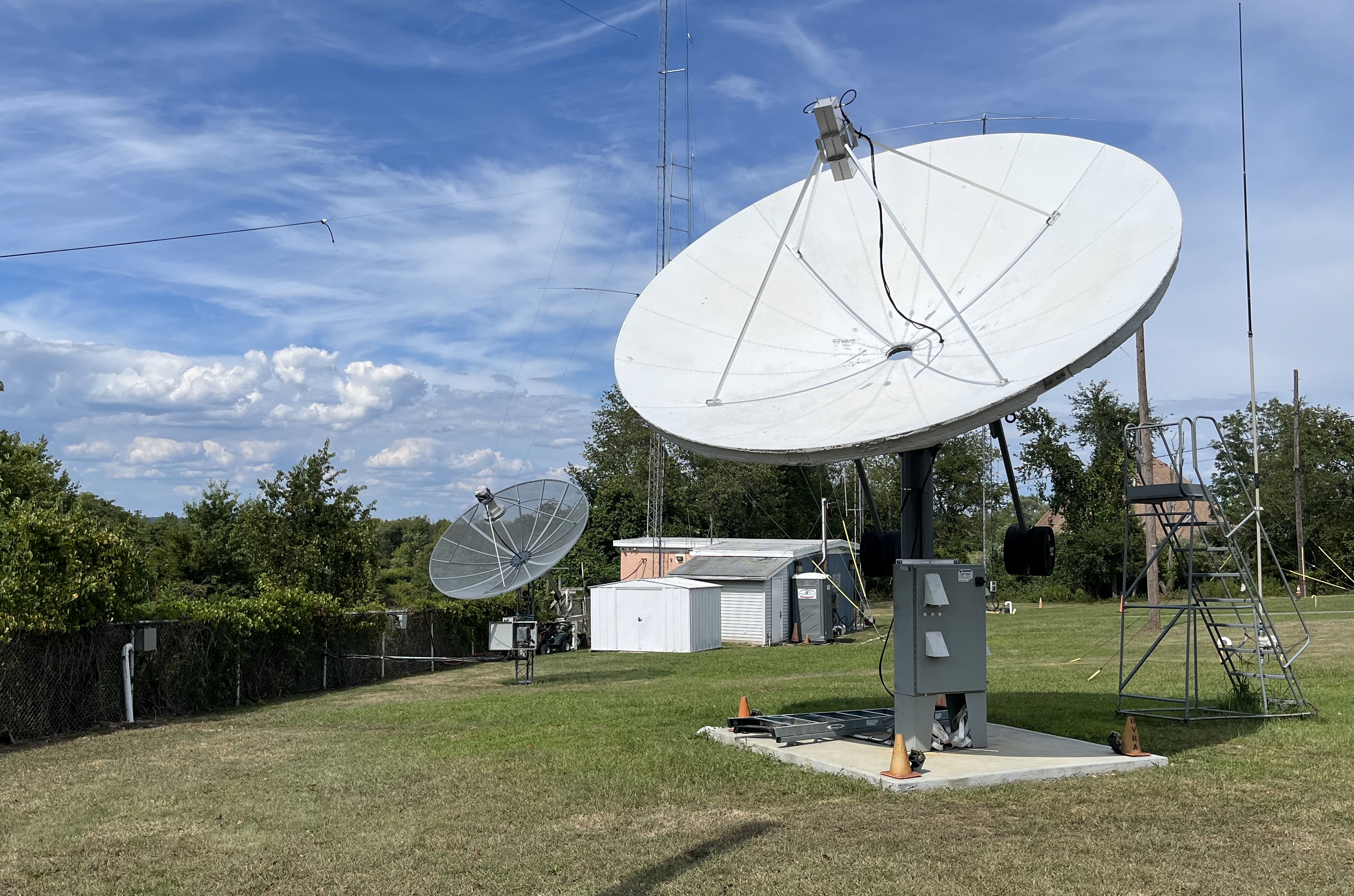 W2ZQ dishes
W2ZQ dishes
WC8RK - Joe WA8OGS
432 MHz Station: 4 x 19 ele GTV70-19 m DG7YBN xpol yagis with Teflon element insulators; WD5AGO cavity LNA, DownEast Microwave LNA; Beko HLV-1470 PA @ 600 watts out; homebrew sequencer by WA3ENK; IC-9700.
We are QRV after many months of completely rebuilding our 432 MHz antenna system. Our original 4 x 15 ele LFA horiz yagis and 2 x 21 ele vert yagis were used for about 2 years, and good for 69 initials.
Our new H-frame of 4 x 19 ele DG7YBN xpol yagis is supported by an aluminum tower section mounted to a hinged tilt-over plate, attached to a trailer hitch on the back of WC8RK’s pickup truck. It takes us about 1 hour to set up the antenna system. The station operating equipment is set up inside a camping trailer (mobile shack), with everything powered with either gas generators or commercial power when available.
Our initial operation with our rebuilt antenna system was in front of the Voice of America Museum (in West Chester OH EM79) on June 22 & 23, and we made just 1 contact with HB9Q. We could not hear… lacking on receive! Changes were needed!
We had coax jumpers from the rear of the yagis to the power dividers that were mounted on the center of X-bracing between the rear of the yagi booms. Additional coax jumpers went from the power dividers to the relays/LNAs at the center of the H-frame. See in picture.
We decided to move the power dividers to the center of the H-frame, with the power dividers attached directly to the relays/preamps (coax jumper only from each yagi to H/V power dividers).
Aug 16 operation: Our second operation resulted in 11 QSOs with 5 new initials: DL8ADU(i), DK0TE, IZ6MVK(i) worked twice, DK3WG, OM4EX(i), SP2WRH, SM4GGC(i), ON7EQ(i), PA3FWV, RD3FD.
We were now hearing better, but still not what we thought it should be. Further improving our system… We used SimpleCalc to help us better understand our overall system, calculate the system noise figure, the effects of cable losses and changing LNA's. We needed more gain in our LNA, so we cascaded a 2nd LNA at the antenna to overcome losses in our receive coax line.
Sept 13 & 14 operation: Success, finally!! We are now able to work 2 yagi stations! We made a total of 24 QSOs, with 13 new initials (i).
On 13th: IZ6MVK, RD3FD, OK1JG (i), SM3LBN, OH3AWW (i), DC1RDB (i), DL1VPL, OE3JPC, DF3RU (i), ON7EQ, OZ7UV (i), G0JDL (i), DK0TE, VE3CIQ (i).
On 14th: KD2LGX, K5N (i), ON7EQ, W4NH (i), GM8JBJ (i), NC1I, F1RJ (i), K3SK (i), DV1VPL, GW4ZHI (i).
Our next project:
• Continue to improve 432 MHz receiving, by learning to set up and use QMAP or MAP65.
• Build a 1296 MHz station, starting with a 1.5 m "Solar Cooker" dish.
Thanks to all who helped us by giving suggestions and listened for and/or worked us.
WC8RK Richard, N8XS Mitch and WA8OGS Joe
June 21 & 22 testing @ Voice of America Museum in West Chester OH (EM79). Note tilt over tower mounting.
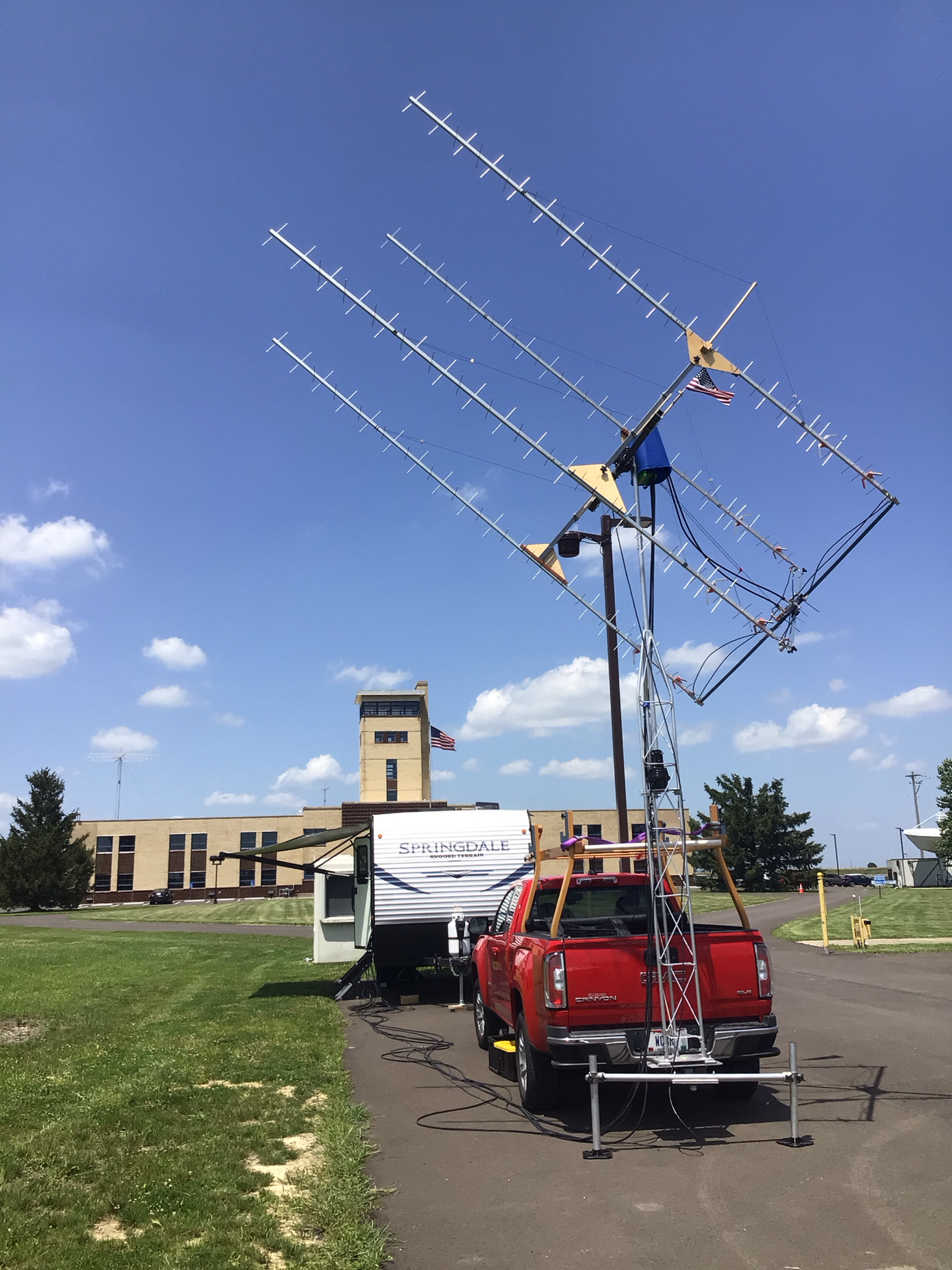 WC8RK testing at VOA museum EM79
WC8RK testing at VOA museum EM79
June 21 & 22 testing: Coax feed lines go from rear of each yagi to H/V power dividers mounted at the X cross-brace. Then another coax jumper from each power divider to the relays/LNAs under WX protection at center of H-frame. Too much coax…could not hear!
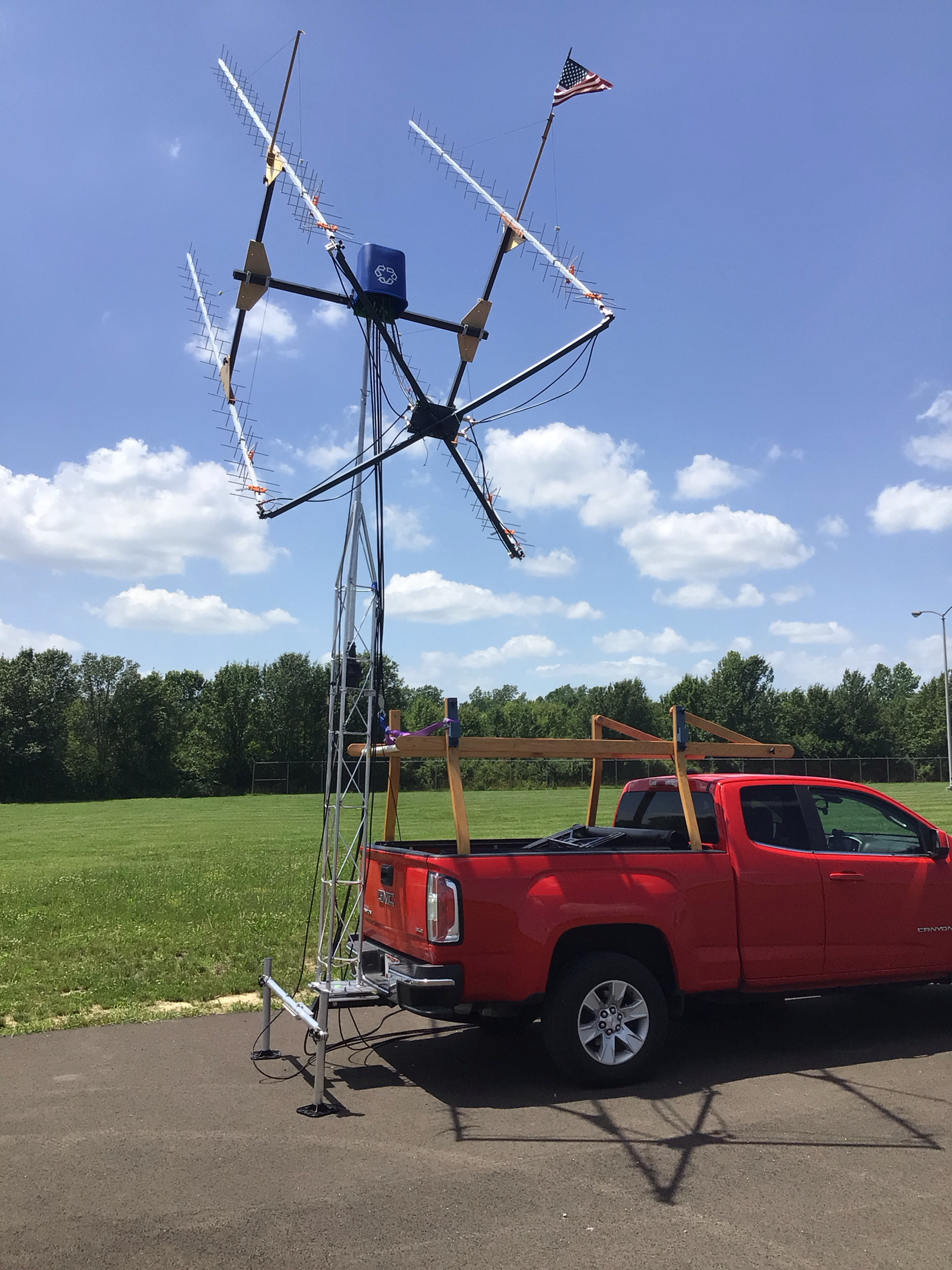 WC8RK initial feed line configuration
WC8RK initial feed line configuration
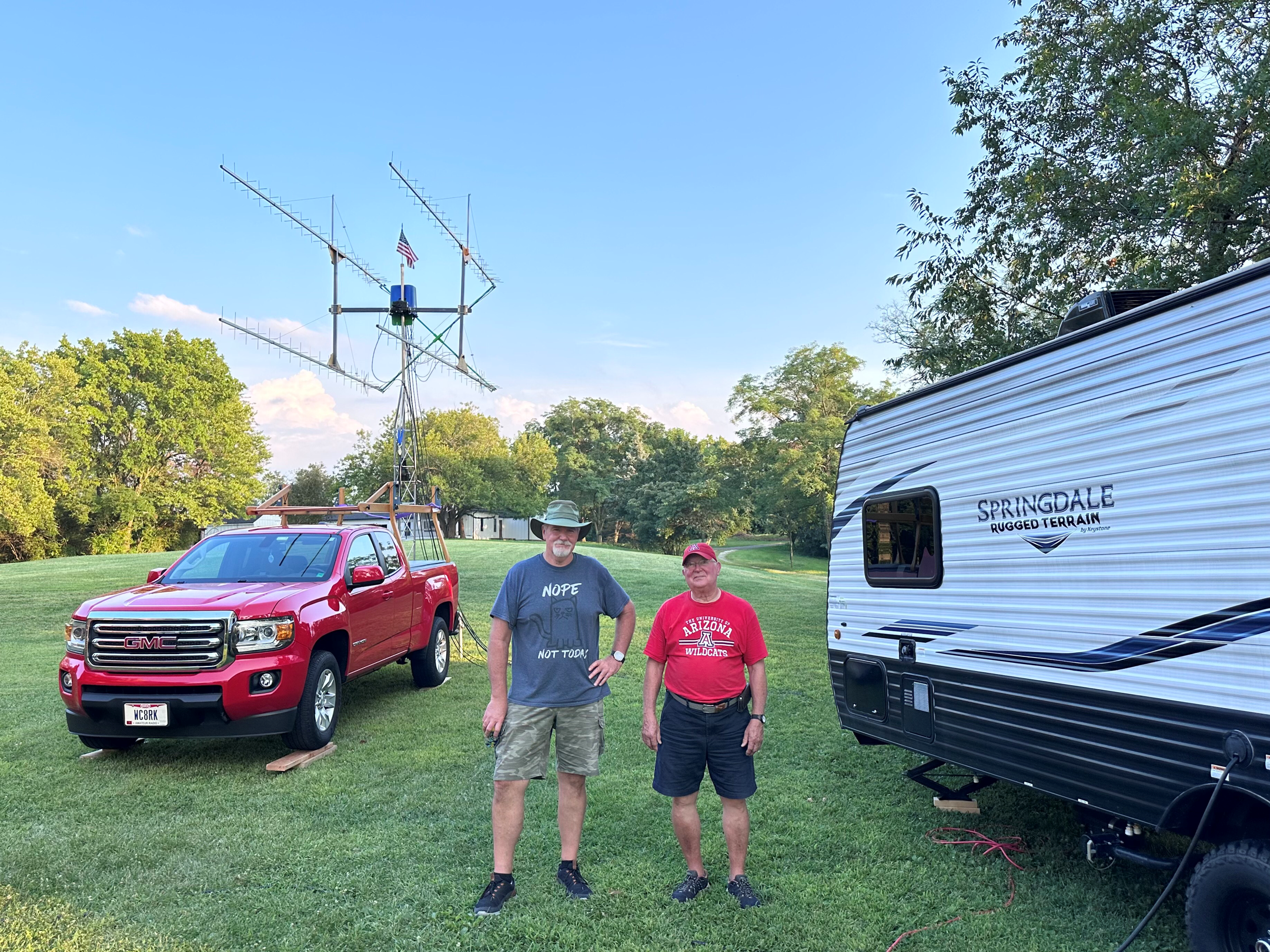 N8XS Mitch (left) WC8RK Richard (right)
N8XS Mitch (left) WC8RK Richard (right)
Power dividers now moved to under relay/LNA weather cover, connected directed to relays with no coax jumpers.
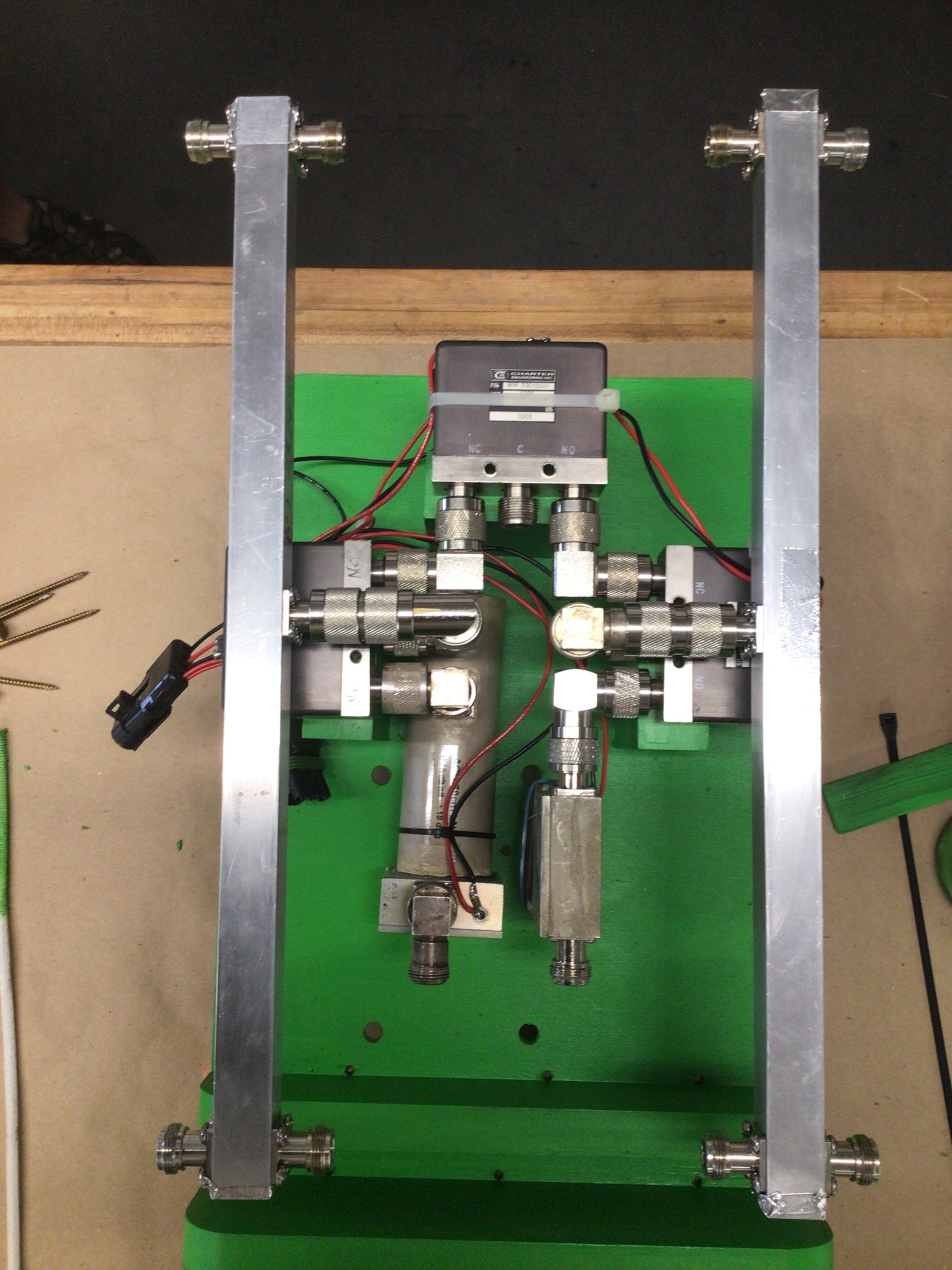 WC8RK power dividers and relays
WC8RK power dividers and relays
Showing relays and LNAs before attaching H and V power dividers. Left center relay is for xmit coax line switching to H or V polarization yagis.
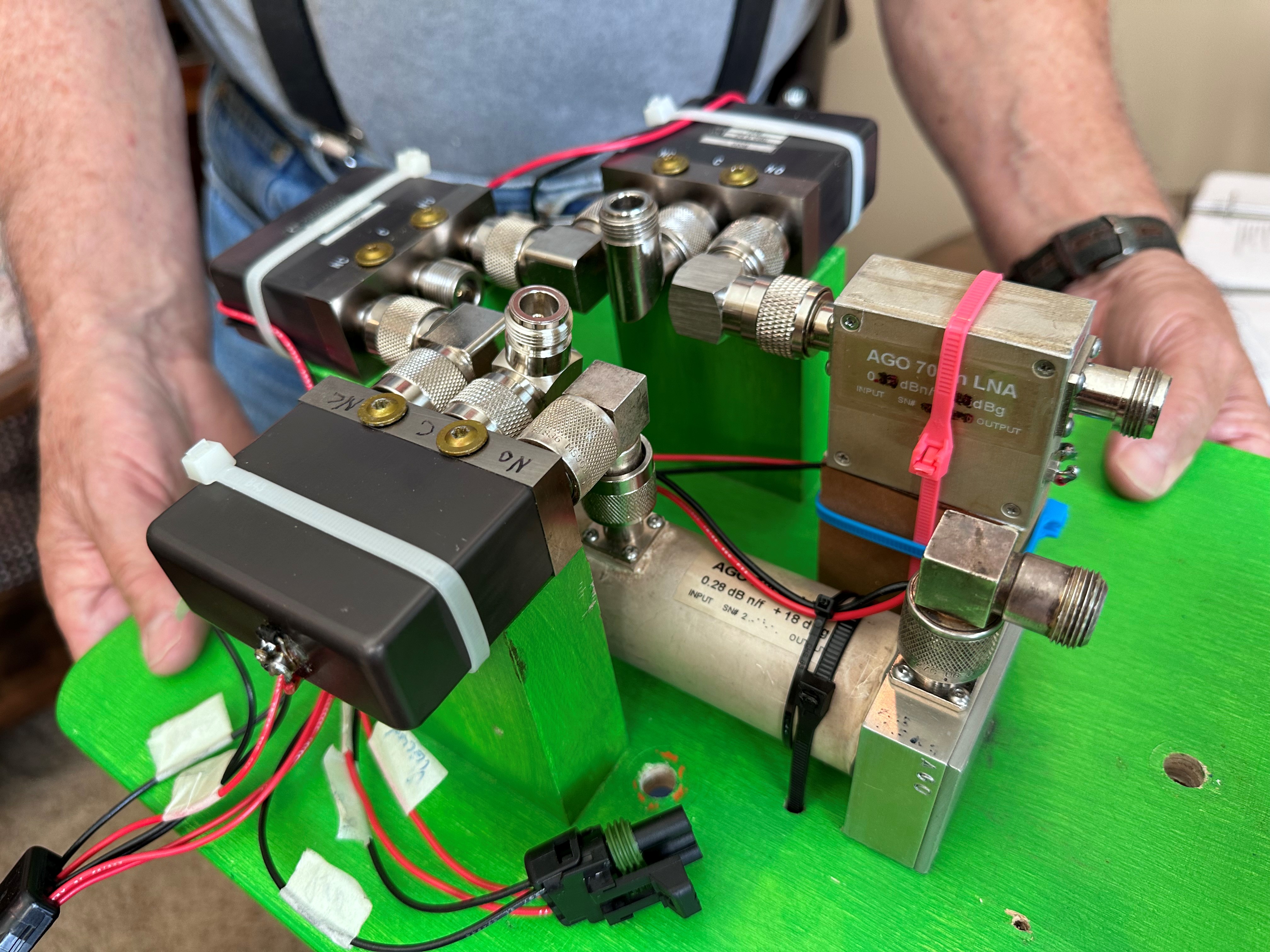 WC8RK relays and LNAs
WC8RK relays and LNAs
WSJT-X v3.0.0 - DL3WDG Charlie
A new joint 3.0.0-rc1 version of WSJT-X and WSJT-X-Improved was released on 15 Sep 2025. This now includes all the features of WSJT-X-improved 2.8.0, as well as some brand new features. EME operators may be interested in two additional capabilities of 'Echo' mode. It is now possible, mainly for fun and demonstrations, to send and receive your own callsign (or any other 6 character string) using a new digital protocol, as well as CW echoes. For more information, see:
https://wsjt.sourceforge.io/wsjtx-doc/wsjtx-main-3.0.0-rc1.html#_echo_mode
The new version can be downloaded using the links below. The code is identical, but WSJT-X-Improved offers alternative GUI layouts and more frequent updates.
https://wsjt.sourceforge.io/wsjtx.html
https://sourceforge.net/projects/wsjt-x-improved/files/WSJT-X_v3.0.0/
LiveCQ
Users of MAP65 and Q65 are now regularly uploading 'spots' of CQ calls. These can be very useful to see who is currently operating, and on what frequency and mode, as well as being able to monitor who is receiving your own transmissions.
The website to view is spots is:
It covers 50 MHz - 24 GHz and up, and it is possible to select which band(s) you want to see, as well as to view the most recent spots. Hint: Click 'None' and then select the band(s) you want to see.
Ephemeris Chart - G3LTF Peter

Take a look at the Moon Ephemeris Chart https://eme.radio/2025-moon-ephemeris. It will be out of date in three months and we have no replacement.
It is the only display of all the essential moon data, declination, excess loss and sun separation that shows the whole year in one place and is invaluable when looking for dates for contests or activity weekends or the best days to operate.
It was started by Frank F5SE in about 2005 and when he died Jean-Jacques, F1EHN re-wrote it in the present form. Sadly JJ died early this year and the software is unavailable.
If you are interested in reproducing it in the same or similar format please contact Peter G3LTF or Bob W1QA.
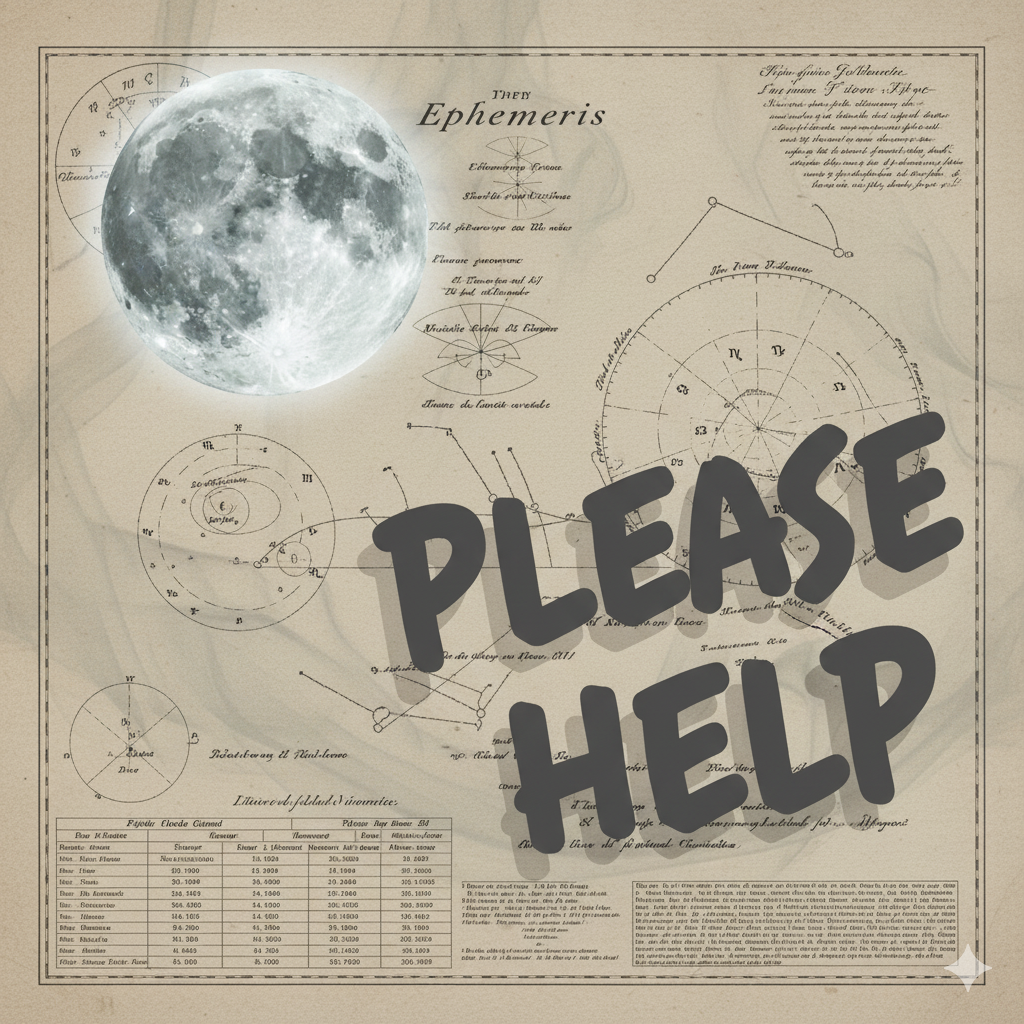 Ephemeris please help
Ephemeris please help